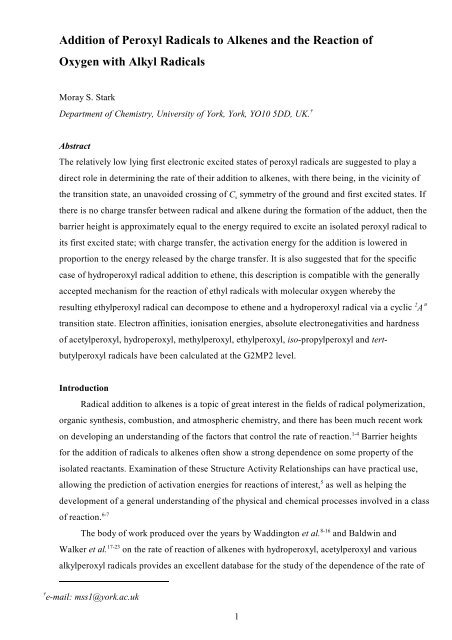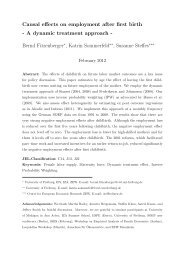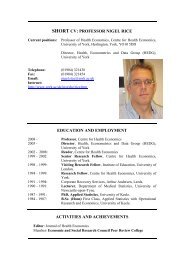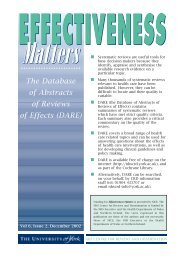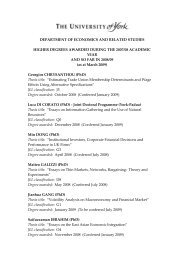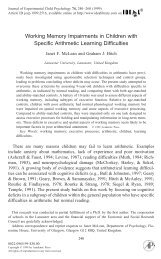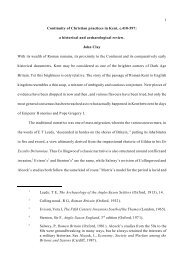Addition of Peroxyl Radicals to Alkenes and the ... - University of York
Addition of Peroxyl Radicals to Alkenes and the ... - University of York
Addition of Peroxyl Radicals to Alkenes and the ... - University of York
Create successful ePaper yourself
Turn your PDF publications into a flip-book with our unique Google optimized e-Paper software.
<strong>Addition</strong> <strong>of</strong> <strong>Peroxyl</strong> <strong>Radicals</strong> <strong>to</strong> <strong>Alkenes</strong> <strong>and</strong> <strong>the</strong> Reaction <strong>of</strong><br />
Oxygen with Alkyl <strong>Radicals</strong><br />
Moray S. Stark<br />
Department <strong>of</strong> Chemistry, <strong>University</strong> <strong>of</strong> <strong>York</strong>, <strong>York</strong>, YO10 5DD, UK. †<br />
Abstract<br />
The relatively low lying first electronic excited states <strong>of</strong> peroxyl radicals are suggested <strong>to</strong> play a<br />
direct role in determining <strong>the</strong> rate <strong>of</strong> <strong>the</strong>ir addition <strong>to</strong> alkenes, with <strong>the</strong>re being, in <strong>the</strong> vicinity <strong>of</strong><br />
<strong>the</strong> transition state, an unavoided crossing <strong>of</strong> C s symmetry <strong>of</strong> <strong>the</strong> ground <strong>and</strong> first excited states. If<br />
<strong>the</strong>re is no charge transfer between radical <strong>and</strong> alkene during <strong>the</strong> formation <strong>of</strong> <strong>the</strong> adduct, <strong>the</strong>n <strong>the</strong><br />
barrier height is approximately equal <strong>to</strong> <strong>the</strong> energy required <strong>to</strong> excite an isolated peroxyl radical <strong>to</strong><br />
its first excited state; with charge transfer, <strong>the</strong> activation energy for <strong>the</strong> addition is lowered in<br />
proportion <strong>to</strong> <strong>the</strong> energy released by <strong>the</strong> charge transfer. It is also suggested that for <strong>the</strong> specific<br />
case <strong>of</strong> hydroperoxyl radical addition <strong>to</strong> e<strong>the</strong>ne, this description is compatible with <strong>the</strong> generally<br />
accepted mechanism for <strong>the</strong> reaction <strong>of</strong> ethyl radicals with molecular oxygen whereby <strong>the</strong><br />
resulting ethylperoxyl radical can decompose <strong>to</strong> e<strong>the</strong>ne <strong>and</strong> a hydroperoxyl radical via a cyclic 2 A<br />
transition state. Electron affinities, ionisation energies, absolute electronegativities <strong>and</strong> hardness<br />
<strong>of</strong> acetylperoxyl, hydroperoxyl, methylperoxyl, ethylperoxyl, iso-propylperoxyl <strong>and</strong> tert-<br />
butylperoxyl radicals have been calculated at <strong>the</strong> G2MP2 level.<br />
Introduction<br />
Radical addition <strong>to</strong> alkenes is a <strong>to</strong>pic <strong>of</strong> great interest in <strong>the</strong> fields <strong>of</strong> radical polymerization,<br />
organic syn<strong>the</strong>sis, combustion, <strong>and</strong> atmospheric chemistry, <strong>and</strong> <strong>the</strong>re has been much recent work<br />
on developing an underst<strong>and</strong>ing <strong>of</strong> <strong>the</strong> fac<strong>to</strong>rs that control <strong>the</strong> rate <strong>of</strong> reaction. 1-4 Barrier heights<br />
for <strong>the</strong> addition <strong>of</strong> radicals <strong>to</strong> alkenes <strong>of</strong>ten show a strong dependence on some property <strong>of</strong> <strong>the</strong><br />
isolated reactants. Examination <strong>of</strong> <strong>the</strong>se Structure Activity Relationships can have practical use,<br />
allowing <strong>the</strong> prediction <strong>of</strong> activation energies for reactions <strong>of</strong> interest, 5 as well as helping <strong>the</strong><br />
development <strong>of</strong> a general underst<strong>and</strong>ing <strong>of</strong> <strong>the</strong> physical <strong>and</strong> chemical processes involved in a class<br />
<strong>of</strong> reaction. 6-7<br />
The body <strong>of</strong> work produced over <strong>the</strong> years by Wadding<strong>to</strong>n et al. 8-16 <strong>and</strong> Baldwin <strong>and</strong><br />
Walker et al. 17-23 on <strong>the</strong> rate <strong>of</strong> reaction <strong>of</strong> alkenes with hydroperoxyl, acetylperoxyl <strong>and</strong> various<br />
alkylperoxyl radicals provides an excellent database for <strong>the</strong> study <strong>of</strong> <strong>the</strong> dependence <strong>of</strong> <strong>the</strong> rate <strong>of</strong><br />
† e-mail: mss1@york.ac.uk<br />
1
eaction on <strong>the</strong> properties <strong>of</strong> both <strong>the</strong> alkene <strong>and</strong> <strong>the</strong> attacking radical. Thirty-six reactions have<br />
been studied in <strong>the</strong> gas-phase, involving five structurally related radicals attacking 17 alkenes, <strong>and</strong><br />
Arrhenius parameters have been determined for most. This class <strong>of</strong> radical - alkene reaction is<br />
also important in <strong>the</strong> au<strong>to</strong>xidation <strong>of</strong> propene <strong>to</strong> propene oxide, a <strong>to</strong>pic which has been<br />
investigated as a possible commercial route for <strong>the</strong> manufacture <strong>of</strong> <strong>the</strong> epoxide. 24-27 Fur<strong>the</strong>r, <strong>the</strong><br />
addition <strong>of</strong> peroxyl radicals <strong>to</strong> alkenes can be <strong>of</strong> significance during <strong>the</strong> au<strong>to</strong>xidation <strong>of</strong><br />
hydrocarbon fuels at relatively low temperatures (below ca. 850 K). 28<br />
The rate <strong>of</strong> addition <strong>of</strong> peroxyl radicals <strong>to</strong> alkenes show a strong dependence on <strong>the</strong> alkene<br />
ionisation energy, with a lower ionisation energy correlating <strong>to</strong> a lower activation energy,<br />
identifying <strong>the</strong> reaction as an electrophilic addition. 10,18 It has also been unders<strong>to</strong>od for some time<br />
that <strong>the</strong> more electrophilic <strong>the</strong> radical, <strong>the</strong> faster <strong>the</strong> reaction rate. 12,13,15,16 However, lack <strong>of</strong> data<br />
for <strong>the</strong> electronic properties <strong>of</strong> peroxyl radicals has prevented <strong>the</strong> quantification <strong>of</strong> this<br />
dependence. So <strong>to</strong> facilitate this analysis, relatively high level ab initio calculations <strong>of</strong> <strong>the</strong> electron<br />
affinities <strong>and</strong> ionisation energies <strong>of</strong> six relevant peroxyl radicals have been performed.<br />
For <strong>the</strong> addition <strong>of</strong> peroxyl radicals <strong>to</strong> alkenes it has recently been demonstrated that all <strong>of</strong><br />
<strong>the</strong> rate constants are strongly correlated <strong>to</strong> <strong>the</strong> degree <strong>of</strong> charge transfer occurring during <strong>the</strong><br />
reaction. 5 This dependence has been re-evaluated <strong>to</strong> account for <strong>the</strong> more accurate peroxyl radical<br />
electron affinities <strong>and</strong> ionisation energies reported here. Also, a description <strong>of</strong> <strong>the</strong> physical<br />
processes involved in <strong>the</strong> addition <strong>of</strong> peroxyl radicals <strong>to</strong> alkenes is suggested, involving low lying<br />
electronically excited states.<br />
The addition <strong>of</strong> hydroperoxyl radicals <strong>to</strong> e<strong>the</strong>ne is <strong>the</strong> simplest reaction <strong>of</strong> this class, <strong>and</strong> as<br />
such has been investigated by Baldwin <strong>and</strong> Walker et al. 20,21 Their proposed mechanism however<br />
has been seen as incompatible with <strong>the</strong> work <strong>of</strong> particularly Gutman et al. 29,30 on <strong>the</strong> reaction <strong>of</strong><br />
molecular oxygen with ethyl radicals. At high temperatures or low pressure, <strong>the</strong> resulting<br />
ethylperoxyl radicals decompose <strong>to</strong> e<strong>the</strong>ne <strong>and</strong> hydroperoxyl radicals, whereas conversely, <strong>the</strong><br />
reverse <strong>the</strong> reaction between e<strong>the</strong>ne <strong>and</strong> hydroperoxyl radicals gives e<strong>the</strong>ne oxide <strong>and</strong> hydroxyl<br />
radicals. 20,21 The debate has been over both <strong>the</strong> reaction mechanism <strong>and</strong> <strong>the</strong> barrier heights <strong>of</strong> key<br />
steps in <strong>the</strong> reaction. The reaction <strong>of</strong> oxygen <strong>and</strong> ethyl radicals has been extensively studied as<br />
being <strong>the</strong> simplest case <strong>of</strong> a reaction <strong>of</strong> oxygen with alkyl radicals that can show decomposition <strong>to</strong><br />
<strong>the</strong> conjugate alkene; a <strong>to</strong>pic <strong>of</strong> paramount importance <strong>to</strong> <strong>the</strong> underst<strong>and</strong>ing hydrocarbon<br />
combustion in au<strong>to</strong>motive engines. 28-32 An attempt is made <strong>to</strong> reconcile <strong>the</strong> radical addition<br />
mechanism reported here with <strong>the</strong> current underst<strong>and</strong>ing on <strong>the</strong> mechanism for <strong>the</strong> reaction <strong>of</strong><br />
oxygen <strong>and</strong> ethyl radicals.<br />
2
Ab Initio Calculations<br />
St<strong>and</strong>ard ab initio quantum chemical calculations were performed using GAUSSIAN 94 33<br />
for <strong>the</strong> anions, radicals <strong>and</strong> cations <strong>of</strong> <strong>the</strong> peroxyl species for which rates <strong>of</strong> addition <strong>to</strong> alkenes<br />
have been measured, namely, acetylperoxyl, hydroperoxyl, methylperoxyl, iso-propylperoxyl <strong>and</strong><br />
tert-butylperoxyl. Ethylperoxyl was also investigated <strong>to</strong> give values for a complete range<br />
alkylperoxyl structures. The calculated zero-point corrected electronic energy at 0 K (E) allowed<br />
<strong>the</strong> determination <strong>of</strong> <strong>the</strong> adiabatic electron affinities (A) <strong>and</strong> ionisation energies (I) via:<br />
A = E neutral - E anion equation 1<br />
I = E cation - E neutral equation 2<br />
Structures <strong>and</strong> energies for HO 2 <strong>and</strong> CH 3O 2 were determined using <strong>the</strong> G1, 34 G2MP2 35 <strong>and</strong><br />
G2 36 procedures, which are approximations <strong>to</strong> calculations <strong>of</strong> <strong>the</strong> electronic energy at <strong>the</strong><br />
QCISD(T)-FC/6-311+G(3df,2p)//MP2=full/6-31G(d) level that assume <strong>the</strong> additivity <strong>of</strong> various<br />
corrective terms that use a larger basis set at lower levels <strong>of</strong> <strong>the</strong>ory, or vice versa. The electron<br />
affinities <strong>and</strong> ionisation energies <strong>of</strong> hydroperoxyl <strong>and</strong> methylperoxyl radicals calculated at more<br />
resource efficient G2MP2 level were within 0.03 eV <strong>of</strong> those found at <strong>the</strong> G1 or G2 levels; this<br />
difference is smaller than <strong>the</strong> typical st<strong>and</strong>ard deviation quoted for G2 calculations <strong>of</strong> ca. 0.04<br />
eV. 37 Therefore calculations for <strong>the</strong> larger species were only performed at <strong>the</strong> G2MP2 level.<br />
Recently, electron affinities have been published for <strong>the</strong> HO 2, C 2H 5O 2 <strong>and</strong> CH 3O 2 radicals at <strong>the</strong><br />
G2MS level, 38 which is a density functional equivalent <strong>to</strong> <strong>the</strong> G2 level; <strong>the</strong>se values were within<br />
0.015 eV <strong>of</strong> <strong>the</strong> G2MP2 calculations reported here.<br />
Geometries were initially optimised at <strong>the</strong> HF/6-31G(d) level with no symmetry restrictions,<br />
<strong>to</strong> confirm that <strong>the</strong> lowest energy structure had C s symmetry ( 2 A ¡ for <strong>the</strong> radical or 1 A ¢ for <strong>the</strong><br />
anion or cation). The geometry <strong>of</strong> <strong>the</strong> lowest energy conformer was <strong>the</strong>n used (with forced C s<br />
symmetry) for <strong>the</strong> G2MP2 calculations. Energies calculated at <strong>the</strong> G2MP2 level <strong>and</strong> geometries<br />
optimised at <strong>the</strong> MP2(Full)/6-31G(d) level are given in <strong>the</strong> supporting literature, whilst electron<br />
affinities, ionisation energies, absolute electronegativities <strong>and</strong> hardness ( £ <strong>and</strong> ¤ respectively,<br />
defined by equations 3 <strong>and</strong> 4) are shown in table 1.<br />
¥ = (I + A)/2 equation 3<br />
¤ = (I - A)/2 equation 4<br />
Optimisations <strong>of</strong> <strong>the</strong> geometry for <strong>the</strong> acetylperoxyl cation would not converge with O 2<br />
bonded <strong>to</strong> <strong>the</strong> acetyl group, with <strong>the</strong> geometry tending <strong>to</strong>wards isolated O 2 <strong>and</strong> CH 3CO +<br />
3
fragments. G2MP2 calculations give an energy for <strong>the</strong> dissociation <strong>of</strong> CH 3C(O)O 2 <strong>to</strong> CH 3CO + +<br />
O 2 + e <strong>of</strong> only 8.539 eV, which is considerably lower than that adiabatic ionisation energy for <strong>the</strong><br />
o<strong>the</strong>r peroxyl radicals examined. While this value might be valid as an estimate <strong>of</strong> <strong>the</strong> adiabatic<br />
ionisation energy <strong>of</strong> acetylperoxyl, it would seem inappropriate for estimating <strong>the</strong> charge transfer<br />
during <strong>the</strong> addition <strong>of</strong> <strong>the</strong> radicals <strong>to</strong> alkenes, where <strong>the</strong> structure <strong>of</strong> <strong>the</strong> peroxyl group would be<br />
expected <strong>to</strong> be similar <strong>to</strong> that <strong>of</strong> <strong>the</strong> radical. A vertical ionisation energy at <strong>the</strong> G2MP2 level was<br />
<strong>the</strong>refore calculated for this species; this value is given in table 1 <strong>and</strong> used in <strong>the</strong> subsequent<br />
analyses.<br />
The calculated G2MP2 electron affinity for hydroperoxyl (1.088 eV) is within one st<strong>and</strong>ard<br />
error <strong>of</strong> <strong>the</strong> experimental result (1.078±0.017 eV), 39 while <strong>the</strong> calculated electron affinity for tert-<br />
butylperoxyl (1.227 eV) is within 0.03 eV <strong>of</strong> <strong>the</strong> measured value (1.20±0.01 eV). 40 The difference<br />
between <strong>the</strong> hydroperoxyl G2MP2 (11.50 eV) <strong>and</strong> experimental ionisation energies (11.35±0.01<br />
eV) 41 <strong>of</strong> 0.15 eV is less than <strong>the</strong> typical maximum error quoted for G2MP2 calculations <strong>of</strong> 0.27<br />
eV. 37 For <strong>the</strong> o<strong>the</strong>r peroxyl radicals examined, experimental results for <strong>the</strong> gas phase electron<br />
affinities <strong>and</strong> ionisation energies are not yet available.<br />
The Mechanism <strong>of</strong> <strong>the</strong> <strong>Addition</strong> <strong>of</strong> <strong>Peroxyl</strong> <strong>Radicals</strong> <strong>to</strong> <strong>Alkenes</strong><br />
The mechanism by which peroxyl radicals add <strong>to</strong> alkenes has been unders<strong>to</strong>od for some<br />
time, primarily through studying <strong>the</strong> reaction <strong>of</strong> <strong>the</strong> radicals with cis- or trans-2-butene. If, for<br />
example, cis-2-butene is reacted with peroxyl radicals, <strong>the</strong>n both cis- <strong>and</strong> trans- isomers <strong>of</strong> <strong>the</strong> 2-<br />
butene epoxide are formed, <strong>and</strong> in <strong>the</strong> same ratio as is found if trans-2-butene is used instead, 17<br />
demonstrating that <strong>the</strong> two butene isomers react via a common peroxyalkyl adduct (reactions 1<br />
<strong>and</strong> 2 show a generic example) 8 . This also demonstrates that <strong>the</strong> intermediate adduct exists as an<br />
independent species for long enough <strong>to</strong> undergo many rotations around <strong>the</strong> C-C bond, so that <strong>the</strong><br />
eventual ring closure <strong>and</strong> decomposition <strong>of</strong> <strong>the</strong> adduct <strong>to</strong> <strong>the</strong> cis- or trans- epoxide has no<br />
memory <strong>of</strong> which isomer <strong>of</strong> <strong>the</strong> alkene was reacted. Fur<strong>the</strong>r, if trans-2-butene is reacted, <strong>the</strong>n <strong>the</strong><br />
dominant products are <strong>the</strong> epoxide isomers, <strong>and</strong> not cis-2-butene, demonstrating that<br />
decomposition <strong>of</strong> <strong>the</strong> peroxyalkyl adduct <strong>to</strong> <strong>the</strong> epoxide dominates over decomposition back <strong>to</strong><br />
<strong>the</strong> alkene (k 2 > k -1). 17,23<br />
k O<br />
1<br />
k2 ROO + C C R O O C C RO + C C<br />
k -1<br />
4<br />
reactions 1, 2<br />
The experiments <strong>of</strong> Wadding<strong>to</strong>n et al., <strong>and</strong> Baldwin <strong>and</strong> Walker et al. all involve end
product analysis <strong>of</strong> a reacting gas mixture, with <strong>the</strong> rate <strong>of</strong> epoxide formation being compared<br />
with <strong>the</strong> formation rate <strong>of</strong> a reference compound. As a consequence <strong>of</strong> <strong>the</strong> peroxyalkyl adduct<br />
predominantly decomposing <strong>to</strong> <strong>the</strong> epoxide, measured rate constants <strong>and</strong> Arrhenius parameters<br />
for epoxide formation can also be taken as representative <strong>of</strong> <strong>the</strong> initial addition <strong>of</strong> <strong>the</strong> peroxyl<br />
group <strong>to</strong> <strong>the</strong> alkene. The mechanistic evidence found from <strong>the</strong> reactions <strong>of</strong> 2-butene is not<br />
available for <strong>the</strong> reaction <strong>of</strong> o<strong>the</strong>r alkenes. However, <strong>the</strong> mechanism described by reactions 1 <strong>and</strong><br />
2 has been assumed <strong>to</strong> be applicable <strong>to</strong> all alkenes, because rate data for a particular peroxyl<br />
radical attacking a series <strong>of</strong> alkenes all show a strong dependence on <strong>the</strong> ionisation energy <strong>of</strong> <strong>the</strong><br />
alkene (figure 1), suggesting a common underlying mechanism.<br />
The variation in rate <strong>of</strong> reaction is dominated by variations in <strong>the</strong> activation energy for <strong>the</strong><br />
reactions over a fairly wide range; from 16 kJ mol -1 for acetylperoxyl + 2-methyl-2-butene 10 <strong>to</strong> 75<br />
kJ mol -1 for hydroperoxyl + e<strong>the</strong>ne 21 (giving, for example, a range <strong>of</strong> rate constants <strong>of</strong> six orders<br />
<strong>of</strong> magnitude at 500 K). In comparison, steric fac<strong>to</strong>rs play a lesser role, with experimentally<br />
determined pre-exponential fac<strong>to</strong>rs covering a range <strong>of</strong> only two orders <strong>of</strong> magnitude. Indeed, <strong>the</strong><br />
A-fac<strong>to</strong>rs for all <strong>the</strong> reported alkyl <strong>and</strong> acyl peroxyl reactions are essentially <strong>the</strong> same within<br />
experimental error at log 10(A/dm 3 mol -1 s -1 ) = 8.1±0.5, eg.5 with those for hydroperoxyl being 10-50<br />
times higher. 21 Therefore any explanation <strong>of</strong> reactivity <strong>of</strong> peroxyl radical addition <strong>to</strong> alkenes is<br />
primarily concerned with <strong>the</strong> fac<strong>to</strong>rs that determine <strong>the</strong> activation energy <strong>of</strong> <strong>the</strong> reaction.<br />
Previous work has demonstrated that <strong>the</strong> rate <strong>of</strong> addition <strong>of</strong> a peroxyl radical <strong>to</strong> an alkene is<br />
strongly dependent on <strong>the</strong> ionisation energy <strong>of</strong> <strong>the</strong> alkene, with a lower ionisation energy giving a<br />
lower activation energy (see for example, figure 1). 10,18 It has also been noted that for a series <strong>of</strong><br />
peroxyl radicals attacking one alkene, <strong>the</strong> reaction is faster <strong>the</strong> higher <strong>the</strong> electrophilicity <strong>of</strong> <strong>the</strong><br />
peroxyl radical. 12,13,15,16 However, in <strong>the</strong> absence <strong>of</strong> measurements or calculations <strong>of</strong> electron<br />
affinities, this observation has only been qualitative. The ab initio calculations described in <strong>the</strong><br />
previous section now allow this dependence <strong>to</strong> be examined quantitatively. Figure 2 shows <strong>the</strong><br />
correlation between peroxyl radical electron affinity <strong>and</strong> <strong>the</strong> rate <strong>of</strong> epoxidation <strong>of</strong> 2-<br />
methylpropene, <strong>the</strong> alkene which has been most thoroughly examined in this context. The electron<br />
affinities <strong>of</strong> <strong>the</strong> alkylperoxyl <strong>and</strong> hydroperoxyl radicals are all fairly similar <strong>to</strong> each o<strong>the</strong>r,<br />
consistent with <strong>the</strong> activation energies for <strong>the</strong>ir addition <strong>to</strong> a particular alkene also being similar.<br />
The electron affinity for acetylperoxyl is substantially higher, again consistent with <strong>the</strong> activation<br />
energy for its addition <strong>to</strong> a particular alkene being much lower than <strong>the</strong> o<strong>the</strong>r peroxyl radicals.<br />
The variation <strong>of</strong> rate <strong>of</strong> epoxidation with peroxyl electron affinity or alkene ionization<br />
energy is usually rationalised by describing <strong>the</strong> reaction as an electrophilic addition, ie. <strong>the</strong><br />
transition state involves a degree <strong>of</strong> electron density transfer <strong>to</strong> <strong>the</strong> radical. 10 This can be<br />
quantified by using <strong>the</strong> parabola model <strong>of</strong> Pearson <strong>and</strong> Parr. 42-45 Figure 3 shows <strong>the</strong> energy <strong>of</strong> <strong>the</strong><br />
5
system as electron density is transferred from one species <strong>to</strong> <strong>the</strong> o<strong>the</strong>r, for <strong>the</strong> example <strong>of</strong><br />
CH 3C(O)O 2 addition <strong>to</strong> 2-methyl-2-butene, which is <strong>the</strong> fastest, most polar epoxidation reaction<br />
that has been reported. 10 The energy for integer charge transfer can be estimated from <strong>the</strong><br />
ionisation energies <strong>and</strong> electron affinities <strong>of</strong> <strong>the</strong> isolated species, with <strong>the</strong> energy at intermediate<br />
fractional charge transfers found by fitting a parabola through <strong>the</strong> three know points (1,I radical -<br />
A alkene), (-1, I alkene - A radical) <strong>and</strong> (0,0). 42-45 This approximation will be valid ins<strong>of</strong>ar as <strong>the</strong> isolated<br />
species retain <strong>the</strong>ir identity at <strong>the</strong> transition state. In this example a charge (¦ N c) <strong>of</strong> 0.19 <strong>of</strong> an<br />
electron flows <strong>to</strong> <strong>the</strong> acetylperoxyl radical releasing an energy (¦ E c) <strong>of</strong> 33 kJ mol -1 . This<br />
behaviour can be expressed quantitatively in terms <strong>of</strong> <strong>the</strong> absolute electronegativity (§ ) <strong>and</strong><br />
hardness (¨ ) <strong>of</strong> <strong>the</strong> isolated species: 42-45<br />
¦ (§ § ¨ alkene)/2(¨<br />
¦ -(§ §<br />
Nc = radical - radical + alkene) equation 5<br />
Ec = radical - alkene) 2 /4(¨ ¨ radical + alkene) equation 6<br />
The energy released (¦ E c) by <strong>the</strong> charge transfer can be interpreted as a driving force for<br />
<strong>the</strong> reaction, which suggests that <strong>the</strong> best correlation <strong>of</strong> rate <strong>of</strong> reaction should be with ¦ E c, <strong>and</strong><br />
not necessarily I alkene-A radical or ¦ N c. The correlation between ¦ E c <strong>and</strong> activation energies for all<br />
peroxyl radical epoxidation reactions that have been measured is given in figure 4, with <strong>the</strong> data<br />
tabulated in <strong>the</strong> supporting literature. It has been re-evaluated using previously collated rate data 5<br />
<strong>and</strong> <strong>the</strong> electronegativities <strong>and</strong> hardnesses reported in table 1. However as can be seen from figure<br />
3, ¦ E c is itself very strongly dependent on ¦ N c or I alkene-A radical, indeed epoxidation activation<br />
energies also show good correlations with I alkene-A radical or ¦ N c. 5<br />
The correlation shown in figure 4 between epoxidation activation energy <strong>and</strong> ¦ E c suggests<br />
that an addition reaction involving no charge transfer would have an activation energy <strong>of</strong> ca. 80-<br />
90 kJ mol -1 , <strong>and</strong> also that <strong>the</strong> energy released by <strong>the</strong> charge transfer lowers <strong>the</strong> barrier for <strong>the</strong><br />
addition approximately in proportion. Interestingly, 80-90 kJ mol -1 is also <strong>the</strong> energy required <strong>to</strong><br />
excite peroxyl radicals <strong>to</strong> <strong>the</strong>ir first electronically state; <strong>the</strong>se values have been included on <strong>the</strong><br />
vertical axis <strong>of</strong> figure 4 <strong>and</strong> are given in table 1. 40,46 This suggests that <strong>the</strong> first excited states <strong>of</strong><br />
<strong>the</strong> peroxyl radical play a role in <strong>the</strong>ir addition <strong>to</strong> alkenes.<br />
This is what would be expected if <strong>the</strong> radical <strong>and</strong> alkene approach each o<strong>the</strong>r with <strong>the</strong><br />
peroxyl radical <strong>and</strong> carbons <strong>of</strong> <strong>the</strong> double bond in <strong>the</strong> same plane (C s symmetry). The ground<br />
states <strong>of</strong> peroxyl radicals have <strong>the</strong> free electron mostly localised in a p-orbital on <strong>the</strong> terminal<br />
oxygen a<strong>to</strong>m that is perpendicular <strong>to</strong> <strong>the</strong> plane <strong>of</strong> <strong>the</strong> radical, (ie. 2 A© for radicals with C s<br />
symmetry), 47 <strong>the</strong>refore <strong>the</strong>re would be no net overlap <strong>and</strong> little reaction. However, <strong>the</strong> first<br />
excited state has <strong>the</strong> free electron in a p-orbital on <strong>the</strong> terminal oxygen that is in <strong>the</strong> plane <strong>of</strong> <strong>the</strong><br />
6
adical ( 2 A for radicals with C s symmetry) 48 <strong>and</strong> can have a net overlap with <strong>the</strong> forming C-O<br />
bond. This is shown schematically in figure 5.<br />
If <strong>the</strong> peroxyl radical approaches <strong>the</strong> vinyl group <strong>of</strong> <strong>the</strong> alkene with C s symmetry, <strong>the</strong><br />
addition reaction can be described by a surface crossing <strong>of</strong> <strong>the</strong> first excited state <strong>of</strong> <strong>the</strong> peroxyl<br />
radical (which correlates with <strong>the</strong> ground state <strong>of</strong> <strong>the</strong> resulting peroxyalkyl radical) with <strong>the</strong><br />
ground state <strong>of</strong> <strong>the</strong> peroxyl radical (which correlates with <strong>the</strong> first excited state <strong>of</strong> <strong>the</strong><br />
peroxyalkyl radical). For <strong>the</strong> case <strong>of</strong> an addition that involves no charge transfer, <strong>the</strong> activation<br />
energy for <strong>the</strong> addition appears similar <strong>to</strong> <strong>the</strong> energy <strong>of</strong> <strong>the</strong> first excited state, <strong>the</strong>refore <strong>the</strong><br />
potential energy surfaces must cross at a value near <strong>to</strong> <strong>the</strong> first excited state. This implies that <strong>the</strong><br />
crossing must be unavoided, also known as a conical intersection. 49 A schematic potential energy<br />
diagram is shown in figure 6.<br />
Unavoided crossings are well know from <strong>the</strong> pho<strong>to</strong>chemistry <strong>of</strong> polya<strong>to</strong>mic molecules. 49 If a<br />
system has, say, F degrees <strong>of</strong> freedom, <strong>the</strong>n <strong>the</strong> dimension <strong>of</strong> <strong>the</strong> subspace in which <strong>the</strong> two<br />
surfaces actually <strong>to</strong>uch is high, at F-2. In <strong>the</strong> remaining two dimensions (<strong>the</strong> branching space) <strong>the</strong><br />
surfaces only <strong>to</strong>uch at a single point, with <strong>the</strong> surfaces diverging on moving away from this point.<br />
The reaction co-ordinates that define <strong>the</strong> branching space are one that maintains <strong>the</strong> high<br />
symmetry <strong>of</strong> <strong>the</strong> system, <strong>and</strong> one that lowers <strong>the</strong> symmetry <strong>of</strong> <strong>the</strong> structure.<br />
A preliminary ab initio investigation <strong>of</strong> <strong>the</strong> addition <strong>of</strong> HO 2 <strong>to</strong> e<strong>the</strong>ne was made at <strong>the</strong><br />
UCIS/6-31(d) level, details are available in <strong>the</strong> supporting literature. The calculated geometry <strong>of</strong><br />
<strong>the</strong> transition state 50 deviates from C s symmetry by having <strong>the</strong> terminal hydrogen a<strong>to</strong>m on <strong>the</strong><br />
hydroperoxyl group out <strong>of</strong> <strong>the</strong> plane <strong>of</strong> <strong>the</strong> CCOO a<strong>to</strong>ms, with a dihedral angle <strong>of</strong> ca. 90 .<br />
Setting this dihedral angle <strong>to</strong> 0 forces C s symmetry on <strong>the</strong> system. The reaction coordinate <strong>of</strong> <strong>the</strong><br />
branching space that maintains <strong>the</strong> high symmetry <strong>of</strong> <strong>the</strong> system can be identified as <strong>the</strong> C-O bond<br />
length (R C-O), <strong>and</strong> with forced C s symmetry an unavoided crossing was identified at R C-O 2.6 Å.<br />
The symmetry lowering reaction coordinate <strong>of</strong> <strong>the</strong> branching space can tentatively be identified as<br />
<strong>the</strong> dihedral angle for <strong>the</strong> COO-H bond, increasing this angle from 0 breaks <strong>the</strong> C s symmetry <strong>of</strong><br />
<strong>the</strong> system <strong>and</strong> lowers <strong>the</strong> energy from <strong>the</strong> conical intersection <strong>and</strong> <strong>to</strong>wards <strong>the</strong> (C 1) transition<br />
state for <strong>the</strong> addition.<br />
It can be argued that <strong>the</strong> height <strong>of</strong> <strong>the</strong> barrier for <strong>the</strong> addition (T 1, figure 6) is determined by<br />
being proximate <strong>to</strong>, <strong>and</strong> lower than, <strong>the</strong> conical intersection. In turn, <strong>the</strong> conical intersection (at<br />
least for reactions involving little charge transfer) must be close in energy <strong>to</strong> that required <strong>to</strong><br />
excite <strong>the</strong> isolated peroxyl <strong>to</strong> its first 2 A excited state. The strong effect <strong>of</strong> charge transfer on <strong>the</strong><br />
T 1 barrier height must be ei<strong>the</strong>r through lowering <strong>of</strong> <strong>the</strong> conical intersection, or increasing <strong>the</strong> gap<br />
between <strong>the</strong> transition state <strong>and</strong> <strong>the</strong> conical intersection; this aspect shall be investigated in future<br />
work.<br />
7
Once <strong>the</strong> barrier (T 1, figure 6) for <strong>the</strong> addition has been surmounted, <strong>the</strong> peroxyalkyl adduct<br />
(which is 2 A for C s symmetry, though <strong>the</strong> lowest energy conformer will be 2 A) can decompose via<br />
<strong>the</strong> relatively constrained but low barrier <strong>to</strong> <strong>the</strong> epoxide (T 2, figure 6), precluding any significant<br />
back reaction <strong>to</strong> reform <strong>the</strong> alkene <strong>and</strong> peroxyl radical. That <strong>the</strong> barrier for decomposition <strong>to</strong> <strong>the</strong><br />
epoxide is lower than that for <strong>the</strong> decomposition back <strong>to</strong> <strong>the</strong> alkene is implicit in <strong>the</strong> good<br />
correlations between <strong>the</strong> epoxide formation <strong>and</strong> <strong>the</strong> properties <strong>of</strong> <strong>the</strong> reactants, such as alkene<br />
ionization energy, 10 <strong>and</strong> that <strong>the</strong> hydroperoxybutyl radical formed by HO 2 + trans-2-butene<br />
decomposes <strong>to</strong> predominantly <strong>to</strong> <strong>the</strong> epoxide <strong>and</strong> not back <strong>to</strong> cis-butene. 17,23<br />
It is informative <strong>to</strong> compare <strong>the</strong> addition <strong>of</strong> peroxyl radicals <strong>to</strong> alkenes, which can have a<br />
significant barrier for <strong>the</strong> reaction, with <strong>the</strong> barrierless addition <strong>of</strong> hydroxyl radicals. 51 In <strong>the</strong><br />
ground<br />
~<br />
( X ) state <strong>of</strong> <strong>the</strong> hydroxyl radical, <strong>the</strong> free electron is also situated in one <strong>of</strong> two 2 p-<br />
orbitals on <strong>the</strong> oxygen a<strong>to</strong>m. However, for this case <strong>the</strong> two states have <strong>the</strong> same energy, at least<br />
until <strong>the</strong> approach <strong>of</strong> <strong>the</strong> e<strong>the</strong>ne molecule lifts <strong>the</strong> degeneracy. The state <strong>of</strong> <strong>the</strong> hydroxyl radical<br />
that correlates with <strong>the</strong> 2 A ground state <strong>of</strong> <strong>the</strong> hydroxyalkyl adduct decreases in energy on <strong>the</strong><br />
approach <strong>of</strong> <strong>the</strong> alkene, giving, <strong>to</strong> a first approximation, a barrierless reaction. Therefore <strong>the</strong> key<br />
fac<strong>to</strong>r in determining <strong>the</strong> difference in reactivity between hydroxyl <strong>and</strong> hydroperoxyl radicals is<br />
that <strong>the</strong> former has a higher symmetry <strong>and</strong> that a ground state <strong>of</strong> <strong>the</strong> radical correlates with <strong>the</strong><br />
ground state <strong>of</strong> <strong>the</strong> adduct, whereas for <strong>the</strong> lower symmetry hydroperoxyl radical, an excited state<br />
correlates with ground state <strong>of</strong> <strong>the</strong> adduct, necessitating a surface crossing at an energy higher<br />
than <strong>the</strong> reactants. It is not necessary <strong>to</strong> presume that <strong>the</strong> hydroxyl radical is in any sense<br />
inherently more reactive than peroxyl radicals <strong>to</strong> explain <strong>the</strong>ir differing reactivities <strong>to</strong>wards<br />
alkenes. Indeed, hydroxyl radicals are not unusually electrophilic; <strong>the</strong> energy released by charge<br />
transfer by addition <strong>to</strong> alkenes (ranging from 19 kJ mol -1 for e<strong>the</strong>ne <strong>to</strong> 40 kJ mol -1 for 2,3-<br />
dimethyl-2-butene) is comparable with <strong>the</strong> range found for peroxyl radicals (3 - 33 kJ mol -1 ).<br />
Also, <strong>the</strong> bond formed by OH addition <strong>to</strong> alkenes is not unusually strong, with <strong>the</strong> addition being<br />
reversible at <strong>the</strong> relatively low temperature <strong>of</strong> 500 - 600 K. 51<br />
Similarly, radical a<strong>to</strong>ms are know <strong>to</strong> undergo barrierless addition <strong>to</strong> alkenes, 52-54 this is<br />
consistent with <strong>the</strong> above explanation for hydroxyl, as <strong>the</strong>y are <strong>of</strong> even higher symmetry than OH.<br />
The reactions <strong>of</strong> three o<strong>the</strong>r tria<strong>to</strong>mic or larger species with alkenes have been examined<br />
extensively (difluoroamino (NF 2, 55,56 ), nitrate (NO 3, 57-59 ) <strong>and</strong> ozone (O 3, 60,61 )); <strong>the</strong>y do have<br />
appreciable activation energies <strong>and</strong> also show strong correlations with <strong>the</strong> ionisation energies <strong>of</strong><br />
<strong>the</strong> alkenes, again indicating electrophilic addition. The behaviour <strong>of</strong> <strong>the</strong>se species will be<br />
investigate in future work.<br />
8
The Reactions <strong>of</strong> Alkyl + O 2 <strong>and</strong> HO 2 + <strong>Alkenes</strong><br />
There has been a long running debate about how <strong>the</strong> widely accepted mechanism describing<br />
<strong>the</strong> reaction <strong>of</strong> alkyl radicals with molecular oxygen relates <strong>to</strong> that for <strong>the</strong> reaction <strong>of</strong><br />
hydroperoxyl radicals with alkenes. Experimental work has shown that while at low temperature<br />
<strong>and</strong> high pressure <strong>the</strong> alkylperoxyl radical is formed from alkyl + O 2 (eg. reaction 3), at high<br />
temperature or low pressure <strong>the</strong> conjugate alkene <strong>and</strong> hydroperoxyl radical are <strong>the</strong> main products<br />
(eg. reaction 4). 29,30 The discussion has tended <strong>to</strong> concentrated on <strong>the</strong> example <strong>of</strong> ethyl + O 2,<br />
which has been <strong>the</strong> system most studied:<br />
C 2H 5 + O 2 C 2H 5O 2 reaction 3<br />
C 2H 4 + HO 2 reaction 4<br />
As <strong>the</strong>re now many reviews <strong>of</strong> this problem in <strong>the</strong> literature, 20,28-32,40,62-64 this section will<br />
only describe <strong>the</strong> two main, apparently irreconcilable, differences between <strong>the</strong> mechanisms. The<br />
first is that for <strong>the</strong> addition <strong>of</strong> HO 2 <strong>to</strong> e<strong>the</strong>ne, <strong>the</strong> work <strong>of</strong> Baldwin <strong>and</strong> Walker et al. supports a<br />
relatively high barrier for <strong>the</strong> initial addition, whereas that <strong>of</strong> Gutman et al. 29,30 on <strong>the</strong> reaction <strong>of</strong><br />
C 2H 5 + O 2 imply that this barrier should be relatively low.<br />
The second point <strong>of</strong> difference is that it was suggested that <strong>the</strong> products formed from <strong>the</strong><br />
HO 2..C 2H 4/O 2..C 2H 5 system should be independent <strong>of</strong> which reactants were used, ie. that <strong>the</strong><br />
products should be independent <strong>of</strong> <strong>the</strong> direction <strong>of</strong> reaction. 30 Therefore, if e<strong>the</strong>ne + HO 2 are <strong>the</strong><br />
main products from C 2H 5 + O 2, <strong>the</strong>n <strong>the</strong> expectation was that reacting HO 2 <strong>and</strong> e<strong>the</strong>ne under <strong>the</strong><br />
same conditions should give ei<strong>the</strong>r adducts that decompose back <strong>to</strong> <strong>the</strong> reactants, or C 2H 5 + O 2 as<br />
<strong>the</strong> main products, <strong>and</strong> not e<strong>the</strong>ne oxide <strong>and</strong> OH as was argued by Baldwin <strong>and</strong> Walker. 20,21<br />
The Mechanism<br />
From <strong>the</strong> work <strong>of</strong> particularly Gutman et al. 29,30 it appears incontrovertible that reacting<br />
oxygen with ethyl radicals leads predominantly <strong>to</strong> <strong>the</strong> alkene at higher temperatures; moni<strong>to</strong>ring<br />
<strong>the</strong> formation <strong>of</strong> <strong>the</strong> epoxide 17,65 or <strong>the</strong> OH radical 66 confirmed that fraction <strong>of</strong> O 2 + ethyl going <strong>to</strong><br />
<strong>the</strong> epoxide is only minor. The potential energy surface suggested by Wagner et al. 30 for <strong>the</strong> C 2H 5<br />
+ O 2 system is given by <strong>the</strong> solid line in figure 7. An important result was that <strong>the</strong> reaction <strong>of</strong><br />
C 2H 5 + O 2 was observed <strong>to</strong> have a negative activation energy, even at higher temperatures where<br />
production <strong>of</strong> <strong>the</strong> e<strong>the</strong>ne was significant. This precluded direct abstraction <strong>of</strong> a hydrogen a<strong>to</strong>m by<br />
<strong>the</strong> oxygen molecule, <strong>and</strong> implied that <strong>the</strong> e<strong>the</strong>ne must be formed via an adduct. Secondly, no<br />
equilibrium was observed for between <strong>the</strong> reactants C 2H 5 + O 2, <strong>and</strong> <strong>the</strong> product, C 2H 5O 2, which<br />
strongly suggested that any barriers <strong>to</strong> fur<strong>the</strong>r reaction must be lower in energy than <strong>the</strong> reactants;<br />
9
<strong>the</strong> fur<strong>the</strong>r reactions being isomerisation <strong>to</strong> <strong>the</strong> hydroperoxyethyl radical (T 1 figure 7 <strong>and</strong> reaction<br />
5), <strong>and</strong> its subsequent decomposition <strong>to</strong> e<strong>the</strong>ne <strong>and</strong> hydroperoxyl (T 2 figure 7 <strong>and</strong> reaction 6).<br />
C 2H 5 + O 2 C 2H 5O 2 reaction 3<br />
C 2H 5O 2 C 2H 4O 2H reaction 5<br />
C 2H 4O 2H C 2H 4 + HO 2 reaction 6<br />
The potential energy diagram for <strong>the</strong> system as suggested by Baldwin <strong>and</strong> Walker 20 is given by <strong>the</strong><br />
dashed line in figure 7 (with C 2H 5 + O 2 as <strong>the</strong> datum). Their reasons for proposing a relatively<br />
high barrier for <strong>the</strong> addition HO 2 + C 2H 4 <strong>and</strong> having C 2H 4O 2H decompose <strong>to</strong> <strong>the</strong> epoxide have<br />
already been described in an earlier section.<br />
There have also been many ab-initio studies on <strong>the</strong> C 2H 5 + O 2 system; <strong>the</strong> work <strong>of</strong> Schaefer<br />
et al. 62-64 refined <strong>the</strong> mechanism <strong>of</strong> Gutman et al. by suggesting that <strong>the</strong> transition state for <strong>the</strong><br />
isomerisation <strong>of</strong> C 2H 5O 2 <strong>to</strong> C 2H 4O 2H (reaction 5) <strong>of</strong> C 1 symmetry (T 2, figure 8), was actually<br />
higher in energy than a 2 A transition state that leads directly <strong>to</strong> C 2H 4 + HO 2 (T 1, figure 8). This<br />
implied that formation <strong>of</strong> C 2H 4O 2H <strong>and</strong> consequently <strong>of</strong> any epoxide could only be very minor.<br />
Therefore ethyl <strong>and</strong> oxygen can react on a single, ground state surface <strong>of</strong> 2 A symmetry <strong>to</strong> form<br />
<strong>the</strong> ethylperoxyl radical, which if not collisionally stabilized, will decompose <strong>to</strong> C 2H 4 + HO 2; a<br />
schematic potential energy diagram is given by <strong>the</strong> solid line in figure 8. Not shown is a loosely<br />
bound complex between C 2H 4 <strong>and</strong> HO 2, which is unlikely <strong>to</strong> greatly affect <strong>the</strong> kinetics <strong>of</strong> <strong>the</strong><br />
system.<br />
Clifford et al. 40 fur<strong>the</strong>r discussed <strong>the</strong> reaction <strong>of</strong> oxygen with alkyl radicals <strong>and</strong> commented<br />
that <strong>the</strong> synchronous pro<strong>to</strong>n transfer mechanism described by Quelch et al. 62 for <strong>the</strong><br />
2<br />
decomposition <strong>of</strong> C2H5O2 <strong>to</strong> HO2 + C2H4 would A ~<br />
actually correlate <strong>the</strong> X ground state <strong>of</strong><br />
C 2H 5O 2 with an energetically unfavourable highly excited<br />
that <strong>the</strong> 2 A transition state (T 1 in figure 8) involved mixing <strong>of</strong> <strong>the</strong><br />
with an excited 2 A state <strong>of</strong> C 2H 5O 2 that did correlate with <strong>the</strong><br />
10<br />
~<br />
B<br />
2 A state <strong>of</strong> HO2. They suggested<br />
~<br />
X<br />
~<br />
X<br />
2 A C2H 5O 2 ground state<br />
2 A ground state <strong>of</strong> HO2 on<br />
decomposition, with <strong>the</strong> latter becoming more significant as <strong>the</strong> reaction proceeds. Alternatively,<br />
<strong>the</strong>y suggested <strong>the</strong> possibility <strong>of</strong> <strong>the</strong> direct decomposition <strong>of</strong> C2H5O2 <strong>to</strong> HO2 + C2H4 via <strong>the</strong> Ã 2 A<br />
first excited state <strong>of</strong> C2H5O2, but since this would correlate with <strong>the</strong> energetically unfavourable<br />
2 A first excited state <strong>of</strong> HO2, <strong>the</strong>y suggest a surface crossing <strong>of</strong> <strong>the</strong> 2 A <strong>and</strong> 2 A states <strong>to</strong> allow<br />
<strong>the</strong> direct formation <strong>of</strong> <strong>the</strong><br />
~<br />
X<br />
2 A ground state <strong>of</strong> HO2. Like Quelch et al., 62 Clifford et al. 40 also<br />
considered <strong>the</strong> formation <strong>of</strong> <strong>the</strong> hydroperoxyethyl radical via an internal hydrogen abstraction<br />
reaction by C 2H 5O 2 <strong>to</strong> form <strong>the</strong> C 2H 4O 2H radical, suggesting that <strong>the</strong> C s symmetry is broken at <strong>the</strong><br />
transition state <strong>to</strong> allow overlap between <strong>the</strong> radical orbital on <strong>the</strong> oxygen <strong>and</strong> <strong>the</strong> abstracted
hydrogen. Like Quelch et al. 62 though, Clifford et al. 40 do not discuss <strong>the</strong> possible decomposition<br />
<strong>of</strong> <strong>the</strong> hydroperoxyalkyl radical <strong>to</strong> <strong>the</strong> epoxide <strong>and</strong> OH.<br />
Pilling et al. 28,31 also recognised <strong>the</strong> importance <strong>of</strong> a low lying electronically excited state in<br />
<strong>the</strong> system <strong>and</strong> proposed a two state mechanism <strong>to</strong> explain <strong>the</strong> formation <strong>of</strong> <strong>the</strong> epoxide, ei<strong>the</strong>r<br />
from C 2H 4 + HO 2 or C 2H 5 + O 2 (figure 8). The 2 A surface, describing <strong>the</strong> reaction <strong>of</strong> C 2H 5 + O 2<br />
<strong>to</strong> C 2H 4 + HO 2 was as suggested by Quelch et al., 63 whilst a 2 A surface connected <strong>the</strong> first<br />
excited state <strong>of</strong> O2 ( 1<br />
g) <strong>and</strong> C2H5O2 ( 2 ), with <strong>the</strong> ground states <strong>of</strong> C2H4O2H ( A 2 ) <strong>and</strong> C2H4O +<br />
A<br />
OH. The small fraction <strong>of</strong> C2H5 + O2 leading <strong>to</strong> <strong>the</strong> epoxide was suggested <strong>to</strong> be due <strong>to</strong><br />
occasional intersystem crossing at point “a” on figure 8 leading <strong>to</strong> formation <strong>of</strong> C 2H 4O 2H <strong>and</strong><br />
subsequently <strong>the</strong> epoxide. The reaction <strong>of</strong> C 2H 4 + HO 2 was suggested <strong>to</strong> lead <strong>to</strong> <strong>the</strong> epoxide<br />
indirectly, via <strong>the</strong> formation <strong>of</strong> <strong>the</strong> ethylperoxyl radical:<br />
C 2H 4 + HO 2 C 2H 5O 2 reaction 7<br />
C 2H 5O 2 (C 2H 4O 2H ) C 2H 4O + HO reaction 8<br />
The relatively high activation energy for <strong>the</strong> formation <strong>of</strong> <strong>the</strong> epoxide from <strong>the</strong> reaction <strong>of</strong><br />
e<strong>the</strong>ne with HO 2 observed by Baldwin <strong>and</strong> Walker et al. 20,21 was explained by assuming that<br />
decomposition <strong>of</strong> <strong>the</strong> ethylperoxyl radical <strong>to</strong> C 2H 4 + HO 2 was <strong>the</strong> dominant route (ie. that k -7 >><br />
k 8) consistent with Gutman’s experimental observations. The rate constant for <strong>the</strong> overall reaction<br />
(9) could <strong>the</strong>n be described by <strong>the</strong> composite expression:<br />
k 9 = k 8( k 7/k -7)<br />
C 2H 4 + HO 2 C 2H 4O + HO reaction 9<br />
The activation energy for <strong>the</strong> overall reaction can be large by assuming a high barrier for <strong>the</strong> 2 A<br />
decomposition <strong>of</strong> C2H4O2H <strong>to</strong> C2H4O + OH (T3, figure 8).<br />
This description is capable <strong>of</strong> rationalising all <strong>the</strong> results from <strong>the</strong> C 2H 5 + O 2/C 2H 4 + HO 2<br />
system. However, as demonstrated by Baldwin <strong>and</strong> Walker, it cannot be valid for describing <strong>the</strong><br />
addition <strong>of</strong> hydroperoxyl <strong>to</strong> 2-butenes or larger alkenes, as, if applicable, reacting HO 2 with trans-<br />
2-butene would lead <strong>to</strong> <strong>the</strong> sec-butylperoxyl radical that would mostly decompose back <strong>to</strong> cis-2-<br />
butene or trans-2-butene, <strong>and</strong> only occasionally <strong>to</strong> <strong>the</strong> epoxides, whereas experimentally,<br />
epoxides <strong>of</strong> 2-butene are observed <strong>to</strong> be <strong>the</strong> main products, not cis-2-butene. 17,23 It is <strong>of</strong> course<br />
possible that HO 2 reacts via a different mechanism with e<strong>the</strong>ne in comparison with 2-butene.<br />
However, <strong>the</strong> structure activity relations described by Baldwin <strong>and</strong> Walker <strong>and</strong> elaborated on in<br />
11
<strong>the</strong> previous section suggest that <strong>the</strong> epoxidation <strong>of</strong> e<strong>the</strong>ne by hydroperoxyl is consistent with<br />
o<strong>the</strong>r hydroperoxyl epoxidation reactions, <strong>and</strong> indeed in line with many o<strong>the</strong>r peroxyl radical<br />
addition reactions.<br />
The description <strong>of</strong> peroxyl radical epoxidation given here, which also involves low lying<br />
excited states, can also be combined with <strong>the</strong> mechanism <strong>of</strong> Gutman et al. 29,30 <strong>and</strong> Schaefer et<br />
al. 62-64 in an attempt <strong>to</strong> reconcile <strong>the</strong> experimental results <strong>of</strong> Gutman et al. with those <strong>of</strong> Baldwin<br />
<strong>and</strong> Walker. From figure 6, if a hydroperoxyl radical approaches an alkene, with <strong>the</strong> system<br />
having C s symmetry, <strong>the</strong>n <strong>the</strong> hydroperoxyl ground 2 A state <strong>and</strong> <strong>the</strong> first excited 2 A state<br />
intersect at some point at an unavoided crossing (marked C.I.). From Quelch et al., 63 <strong>the</strong> 2 A<br />
hydroperoxyl radical will be directly connected <strong>to</strong> <strong>the</strong> 2 A transition state (T 1, figure 9) for <strong>the</strong><br />
decomposition <strong>of</strong> <strong>the</strong> alkylperoxyl radical <strong>to</strong> <strong>the</strong> alkene, again shown schematically by <strong>the</strong> solid<br />
line in figure 9.<br />
The 2 A first excited state <strong>of</strong> <strong>the</strong> hydroperoxyl radical connects <strong>to</strong> <strong>the</strong> 2 A ground state <strong>of</strong><br />
<strong>the</strong> hydroperoxyalkyl radical, which in turn connects <strong>to</strong> <strong>the</strong> 2 A first excited state <strong>of</strong> <strong>the</strong><br />
alkylperoxyl radical, via a 2 A transition state (T 2, figure 9) as suggested by Quelch et al. 63 <strong>and</strong><br />
Pilling et al. 28,31 (shown by <strong>the</strong> dotted line in figure 9). Also shown is <strong>the</strong> 2 A transition state (T 3)<br />
for <strong>the</strong> addition <strong>of</strong> HO 2 <strong>to</strong> <strong>the</strong> alkene <strong>to</strong> form <strong>the</strong> hydroperoxyl radical, which is contiguous with,<br />
<strong>and</strong> necessarily lower than, <strong>the</strong> conical intersection. For clarity <strong>the</strong> route for <strong>the</strong> decomposition <strong>of</strong><br />
<strong>the</strong> hydroperoxyalkyl radical <strong>to</strong> <strong>the</strong> epoxide is not shown. The 2 A <strong>and</strong> 2 A states for <strong>the</strong> system<br />
will be described by two reaction co-ordinates that will be largely independent, <strong>and</strong> will only<br />
coincide at <strong>the</strong> conical intersection; it is not suggested that <strong>the</strong>re is any surface crossing between<br />
T 1 <strong>and</strong> T 2.<br />
A conical intersection differs in an important respect from a transition state, in that <strong>the</strong><br />
behaviour <strong>of</strong> <strong>the</strong> system depends not only on <strong>the</strong> coordinates <strong>of</strong> <strong>the</strong> nuclei, but also on nuclear<br />
motion, 49 hence it is necessary <strong>to</strong> consider <strong>the</strong> dynamics <strong>of</strong> <strong>the</strong> system. The reaction <strong>of</strong> C 2H 5 <strong>and</strong><br />
O 2 will produce C 2H 5O 2 radicals, which will react fur<strong>the</strong>r if <strong>the</strong>y have enough energy. Since <strong>the</strong><br />
lowest energy transition state (T 1) has C s symmetry, those ethylperoxyl radicals that do react via<br />
T 1 will tend <strong>to</strong> have geometries near <strong>to</strong> C s symmetry, particularly at lower temperatures. After<br />
crossing <strong>the</strong> transition state, nuclear motion will carry <strong>the</strong> radical on <strong>the</strong> 2 A surface <strong>to</strong>wards <strong>the</strong><br />
conical intersection. At <strong>the</strong> crossing point, <strong>the</strong> system is not likely <strong>to</strong> go <strong>to</strong> <strong>the</strong> hydroperoxyalkyl<br />
radical; nuclear motion will ensure that formation <strong>of</strong> <strong>the</strong> conjugate alkene <strong>and</strong> hydroperoxyl<br />
dominates.<br />
However, <strong>the</strong> reaction in <strong>the</strong> reverse direction (<strong>the</strong> addition <strong>of</strong> HO 2 <strong>to</strong> alkenes) need not<br />
necessarily give <strong>the</strong> alkylperoxyl radical as a significant product. One reason is that <strong>the</strong> barrier for<br />
<strong>the</strong> addition (T 3) is necessarily lower than <strong>the</strong> conical intersection, which in turn is lower than <strong>the</strong><br />
12
2 A transition state (T1) that would give <strong>the</strong> alkylperoxyl radical. Hence formation <strong>of</strong> <strong>the</strong><br />
hydroperoxylalkyl radical (<strong>and</strong> subsequent decomposition <strong>to</strong> <strong>the</strong> epoxide) will tend <strong>to</strong> dominate<br />
for energetic reasons.<br />
The barrier heights given in figure 9 are for <strong>the</strong> specific example <strong>of</strong> <strong>the</strong> C 2H 5 + O 2/C 2H 4 +<br />
HO 2 system <strong>and</strong> are discussed in <strong>the</strong> next section. For this system, <strong>the</strong> height <strong>of</strong> T 1 is actually<br />
sufficiently close <strong>to</strong> T 3 <strong>to</strong> suggest that a significant proportion <strong>of</strong> C 2H 4 + HO 2 could in fact go <strong>to</strong><br />
C 2H 5O 2 <strong>and</strong> not C 2H 4O 2H. However, this route would not affect <strong>the</strong> C 2H 4 + HO 2 experiments <strong>of</strong><br />
Baldwin <strong>and</strong> Walker as only <strong>the</strong> formation <strong>of</strong> e<strong>the</strong>ne oxide was moni<strong>to</strong>red, 20,21 <strong>and</strong> any C 2H 5O 2<br />
formed at <strong>the</strong> temperatures used (653 - 773 K) would decompose back <strong>to</strong> C 2H 4 + HO 2. This does<br />
not however contradict <strong>the</strong> experiments <strong>of</strong> Baldwin <strong>and</strong> Walker on HO 2 + trans-2-butene, 17,23<br />
which found <strong>the</strong> formation <strong>of</strong> <strong>the</strong> epoxide <strong>and</strong> not cis-2-butene, since <strong>the</strong> barrier for <strong>the</strong> formation<br />
<strong>of</strong> <strong>the</strong> hydroperoxylbutyl radical (equivalent <strong>to</strong> T 3, figure 9) is some 20 kJ mol -1 lower than for<br />
HO 2 + e<strong>the</strong>ne, so at least for <strong>the</strong> reactions <strong>of</strong> trans-2-butene, <strong>the</strong> epoxide would still be expected<br />
<strong>to</strong> be <strong>the</strong> dominant product. This argument could be checked by examining whe<strong>the</strong>r HO 2<br />
catalysed <strong>the</strong> isomerisation <strong>of</strong> cis-dideuteroe<strong>the</strong>ne <strong>to</strong> trans-dideuteroe<strong>the</strong>ne <strong>and</strong> did not just form<br />
<strong>the</strong> epoxide.<br />
There is ano<strong>the</strong>r reason for <strong>the</strong> addition <strong>of</strong> HO 2 <strong>to</strong> alkenes giving <strong>the</strong> hydroperoxylalkyl<br />
radical, <strong>and</strong> not <strong>the</strong> corresponding alkylperoxyl radical. Consider an alkylperoxyl radical reacting<br />
via T 1 (figure 9) <strong>and</strong> approaching <strong>the</strong> conical intersection on <strong>the</strong> upper surface; in <strong>the</strong> two degrees<br />
<strong>of</strong> freedom <strong>of</strong> <strong>the</strong> branching space, <strong>the</strong> conical intersection would tend <strong>to</strong> act as an attrac<strong>to</strong>r <strong>and</strong><br />
<strong>the</strong> radical would be funnelled <strong>to</strong>wards it. On approaching <strong>the</strong> bot<strong>to</strong>m <strong>of</strong> <strong>the</strong> conical intersection,<br />
<strong>the</strong> radical would transfer <strong>to</strong> <strong>the</strong> ground state <strong>and</strong> carry on <strong>to</strong> decompose <strong>to</strong> <strong>the</strong> alkene <strong>and</strong> HO 2.<br />
However, approaching <strong>the</strong> conical intersection on <strong>the</strong> lower surface (from HO 2 + alkene), <strong>the</strong><br />
conical intersection acts as a repeller, ie. if <strong>the</strong> system was slightly <strong>of</strong>f C s symmetry, <strong>the</strong>n <strong>the</strong><br />
symmetry breaking coordinate (<strong>the</strong> dihedral angle for <strong>the</strong> COO-H bond) would increase in<br />
magnitude on approaching <strong>the</strong> conical intersection, preventing <strong>the</strong> system from passing through<br />
<strong>the</strong> intersection. This would make <strong>the</strong> formation <strong>of</strong> <strong>the</strong> alkylperoxyl radical much less likely <strong>to</strong><br />
occur, even if energetically possible.<br />
This mechanism is consistent with <strong>the</strong> work <strong>of</strong> Baker et al. 17 who moni<strong>to</strong>red <strong>the</strong> formation<br />
<strong>of</strong> epoxide <strong>and</strong> conjugate alkene <strong>and</strong> that <strong>of</strong> Clague, 66 who moni<strong>to</strong>red <strong>the</strong> formation <strong>of</strong> OH<br />
radicals, during <strong>the</strong> reaction <strong>of</strong> O 2 + alkyl. Both came <strong>to</strong> <strong>the</strong> conclusion that <strong>the</strong>ir results were<br />
best explained by a mechanism in which <strong>the</strong> conjugate alkene was formed directly from <strong>the</strong><br />
decomposition <strong>of</strong> <strong>the</strong> alkylperoxyl radical, <strong>and</strong> not via an isomerisation <strong>to</strong> <strong>the</strong> hydroperoxyalkyl<br />
radical. Clifford et al. 40 recently suggested that <strong>the</strong> reaction <strong>of</strong> alkyl radicals with O 2 would lead <strong>to</strong><br />
a proportion <strong>of</strong> <strong>the</strong> resultant chemically activated alkylperoxyl radical being in <strong>the</strong> first excited<br />
13
state. If not collisionally stabilised, a 2 A alkylperoxyl radical with enough energy can isomerise<br />
via <strong>the</strong> 2 A internal hydrogen transfer transition state (T 2, figure 9) <strong>to</strong> form <strong>the</strong> hydroperoxyalkyl<br />
radical, which can decompose <strong>to</strong> <strong>the</strong> small quantities <strong>of</strong> epoxide <strong>and</strong> OH observed by Baker et<br />
al. 17 <strong>and</strong> Clague. 66<br />
Barrier Heights for <strong>the</strong> C 2H 5 + O 2 /C 2H 4 + HO 2 System<br />
The above description can help explain why <strong>the</strong> reaction <strong>of</strong> oxygen with alkyl radicals leads<br />
<strong>to</strong> <strong>the</strong> formation <strong>of</strong> <strong>the</strong> conjugate alkene <strong>and</strong> HO 2, while <strong>the</strong> reverse reaction <strong>of</strong> hydroperoxyl<br />
radical addition <strong>to</strong> an alkene gives <strong>the</strong> epoxide. However, <strong>the</strong> mechanism appears <strong>to</strong> require that<br />
any unavoided crossing should be lower in energy than <strong>the</strong> heat <strong>of</strong> formation <strong>of</strong> alkyl + O 2.<br />
This requirement can be satisfied by propene or larger alkenes, as <strong>the</strong>y have barriers for HO 2<br />
addition that are comparatively low. However, for e<strong>the</strong>ne itself, it remains difficult <strong>to</strong> reconcile<br />
<strong>the</strong> high barrier (E -6 = 74.7±4.5 kJ mol 1 ) for C 2H 4 + HO 2 found by Baldwin <strong>and</strong> Walker et al. 21<br />
with <strong>the</strong> implication from <strong>the</strong> work <strong>of</strong> Gutman et al. 29,30 that E -6 should be lower than <strong>the</strong> heat <strong>of</strong><br />
reaction for e<strong>the</strong>ne + HO 2 <strong>to</strong> ethyl + O 2 ( H r(298K) = 56.0±4.6 kJ mol -1 ) 40 . Indeed Wagner et<br />
al. 30 quote a value <strong>of</strong> E -6 25 kJ mol -1 , based on <strong>the</strong>rmochemical estimates by Benson, 67 which in<br />
turn were based on a presumed similarity between <strong>the</strong> addition <strong>to</strong> alkenes <strong>of</strong> HO 2 <strong>and</strong> O( 1 D)<br />
radicals.<br />
The conclusion that <strong>the</strong> barrier (E -6) should be lower than 56.0±4.6 kJ mol -1 was largely<br />
based on <strong>the</strong> absence <strong>of</strong> an observation <strong>of</strong> an equilibrium for <strong>the</strong> reaction C 2H 5 + O 2 C 2H 5O 2.<br />
Subsequently though, Gutman et al. 68 did report a small temperature range (up <strong>to</strong> 660 K) where<br />
an equilibrium could be observed. However, in a detailed RRKM kinetic analysis <strong>of</strong> <strong>the</strong> system,<br />
Wagner et al. 30 varied parameters in a four reaction model <strong>to</strong> obtain agreement with experiment,<br />
<strong>and</strong> found an optimal value for <strong>the</strong> barrier height for <strong>the</strong> rate determining step in <strong>the</strong> formation <strong>of</strong><br />
e<strong>the</strong>ne (T 1, figure 7) <strong>of</strong> 16 kJ/mol below H 298K(C 2H 5 + O 2). Fur<strong>the</strong>r work by Kaiser 69 determined<br />
<strong>the</strong> apparent activation energy for <strong>the</strong> reaction C 2H 5 + O 2 C 2H 4 + HO 2 as 4.6±1.0 kJ mol -1 ,<br />
though again this was interpreted as being consistent with <strong>the</strong> low barrier for T 1 suggested by<br />
Wagner et al. 30<br />
It should be noted however, that in <strong>the</strong> analysis <strong>of</strong> Wagner et al. 30 <strong>the</strong> parameters that were<br />
floated <strong>to</strong> obtain an optimum fit were not uniquely determined; it was stated that o<strong>the</strong>r<br />
combinations <strong>of</strong> parameters could give an equivalent match between <strong>the</strong>ory <strong>and</strong> experiment. This<br />
raises <strong>the</strong> possibility that <strong>the</strong> barrier height <strong>of</strong> T 1 (figure 7) could actually be higher than<br />
H 298K(C 2H 5 + O 2). This would allow a straightforward explanation <strong>of</strong> <strong>the</strong> observation <strong>of</strong> an<br />
equilibrium for <strong>the</strong> reaction C 2H 5 + O 2 C 2H 5O 2. That <strong>the</strong> equilibrium was not observed above a<br />
certain ceiling temperature (660 K) indicates that <strong>the</strong> barrier height could only be higher than<br />
14
H298K(C 2H 5 + O 2) by a small margin; at higher temperatures a significant proportion <strong>of</strong> <strong>the</strong><br />
population would go straight over <strong>the</strong> barrier <strong>to</strong> form e<strong>the</strong>ne, preventing a significant<br />
decomposition <strong>of</strong> C 2H 5O 2 back <strong>to</strong> C 2H 5 + O 2. It can be suggested that <strong>the</strong> small apparent<br />
activation energy report by Kaiser 69 actually does represent <strong>the</strong> height <strong>of</strong> <strong>the</strong> barrier for <strong>the</strong> rate<br />
determining step in <strong>the</strong> formation <strong>of</strong> e<strong>the</strong>ne T 1, figure 9 (ie. E 4 4.6±1.0 kJ mol -1 ).<br />
If this was accepted, it could <strong>the</strong>refore be argued that <strong>the</strong> barrier for <strong>the</strong> addition <strong>of</strong><br />
hydroperoxyl <strong>to</strong> e<strong>the</strong>ne (E -6) need only be less than 60.6±4.7 kJ mol -1 <strong>to</strong> not contradict <strong>the</strong><br />
findings <strong>of</strong> Gutman et al. The difference between <strong>the</strong> value for E -6 implied by Kaiser’s work, <strong>and</strong><br />
<strong>the</strong> determination <strong>of</strong> 74.7±4.5 kJ mol -1 by Baldwin <strong>and</strong> Walker 21 is 14.0±6.5 kJ (<strong>the</strong> error quoted<br />
is 1 , <strong>the</strong> 95% confidence limit would be ca. ±14 kJ mol -1 ). This difference between <strong>the</strong>se two<br />
determinations <strong>of</strong> E -6 would clearly benefit from being addressed by fur<strong>the</strong>r experimental<br />
investigation; however, <strong>the</strong>y do not differ by such a large margin as <strong>to</strong> be considered<br />
fundamentally irreconcilable. The E -6 value implied by Kaiser’s E 4 = 4.6±1.0 kJ mol -1 , is unlikely<br />
<strong>to</strong> be <strong>the</strong> source <strong>of</strong> <strong>the</strong> discrepancy, since even a hypo<strong>the</strong>tical relative error <strong>of</strong>, say, 50% in <strong>the</strong><br />
measured value would only give an absolute error <strong>of</strong> 2-3 kJ mol -1 . The E -6 value <strong>of</strong> Baldwin <strong>and</strong><br />
Walker though, since it is measured from <strong>the</strong> much lower baseline <strong>of</strong> <strong>the</strong> heat <strong>of</strong> formation <strong>of</strong><br />
C 2H 4 + HO 2, will be more susceptible <strong>to</strong> error.<br />
Baldwin <strong>and</strong> Walker’s determinations <strong>of</strong> epoxidation rate constants (along with virtually all<br />
o<strong>the</strong>r epoxidation rate constants) were determined by a relative rate method. There has however<br />
been one reported epoxidation rate constant obtained by more “direct” methods. Arsentiev et<br />
al. 70,71 moni<strong>to</strong>red <strong>the</strong> <strong>to</strong>tal peroxyl radical concentration in <strong>the</strong> gas phase by ESR during <strong>the</strong><br />
au<strong>to</strong>xidation <strong>of</strong> e<strong>the</strong>ne. The rate <strong>of</strong> production <strong>of</strong> <strong>the</strong> e<strong>the</strong>ne oxide was found <strong>to</strong> correlate well<br />
with <strong>the</strong> product <strong>of</strong> <strong>the</strong> peroxyl radical <strong>and</strong> alkene concentrations <strong>and</strong> was used <strong>to</strong> derive<br />
(effectively, species averaged) rate constants for <strong>the</strong> epoxidation <strong>of</strong> <strong>the</strong> e<strong>the</strong>ne by <strong>the</strong> peroxyl<br />
radicals present. For e<strong>the</strong>ne au<strong>to</strong>xidation at <strong>the</strong> temperatures used (637-688 K), <strong>the</strong> dominant<br />
peroxyl radical present is very likely <strong>to</strong> be <strong>the</strong> hydroperoxyl radical, so <strong>the</strong> rate constant <strong>of</strong><br />
Arsentiev et al. 70,71 can be used <strong>to</strong> give a barrier height for <strong>the</strong> addition <strong>of</strong> HO 2 <strong>to</strong> e<strong>the</strong>ne <strong>of</strong> E -6 =<br />
56.6±3.4 kJ mol -1 . This value is consistent with that derived from Kaiser’s work <strong>of</strong> 60.7±4.6 kJ<br />
mol -1 . Arsentiev’s solitary, directly measured value for E -6 cannot on its own provide compelling<br />
evidence that Baldwin <strong>and</strong> Walker’s value 21 is <strong>to</strong>o high by ca. 15 kJ mol -1 . Never<strong>the</strong>less, it does at<br />
least highlight <strong>the</strong> need for fur<strong>the</strong>r direct experiments on <strong>the</strong> HO 2 + C 2H 4 reaction.<br />
Baldwin <strong>and</strong> Walker 19,21 determined <strong>the</strong> rate constant for <strong>the</strong> epoxidation <strong>of</strong> e<strong>the</strong>ne <strong>and</strong><br />
propene by competition with <strong>the</strong> hydroperoxyl radical self reaction. Subsequent determinations<br />
for o<strong>the</strong>r alkenes 18,20,22,23 were by competition with propene or e<strong>the</strong>ne. Hence if it was suggested<br />
that <strong>the</strong> activation energies for propene <strong>and</strong> e<strong>the</strong>ne were <strong>to</strong>o high by ca. 15 kJ mol -1 , all <strong>the</strong>ir<br />
15
o<strong>the</strong>r evaluations would also need <strong>to</strong> be reduced, thus maintaining <strong>the</strong> excellent correlation<br />
between activation energy <strong>and</strong> alkene ionization energy that <strong>the</strong>y observed. The H r(298 K)<br />
energies quoted in figure 9 are sourced from; C 2H 4 + HO 2, 40 T 1, 69 T 3, 70,71 C 2H 4O 2H, 64 T 2 from<br />
evaluations <strong>of</strong> a 1,4p hydrogen transfer reaction 31 <strong>and</strong> excited states. 46<br />
If it were accepted that E -6 60 kJ mol -1 , E 4 5 kJ mol -1 <strong>and</strong> that <strong>the</strong>re was an unavoided<br />
crossing <strong>of</strong> <strong>the</strong> 2 A <strong>and</strong> 2 A states <strong>of</strong> <strong>the</strong> system in <strong>the</strong> vicinity <strong>of</strong> <strong>the</strong> transition state for <strong>the</strong><br />
addition <strong>of</strong> <strong>the</strong> peroxyl <strong>to</strong> <strong>the</strong> alkene, <strong>the</strong>n <strong>the</strong> benefits for <strong>the</strong> underst<strong>and</strong>ing <strong>of</strong> hydrocarbon<br />
oxidation are considerable, as it could be contended that <strong>the</strong> two well developed mechanisms<br />
describing O 2+ alkyl alkene + HO 2 <strong>and</strong> HO 2 (or RO 2) + alkene epoxide + OH (or RO) are<br />
able <strong>to</strong> co-exist without contradiction.<br />
Conclusions<br />
Ab-initio calculations <strong>of</strong> <strong>the</strong> electronic properties <strong>of</strong> selected peroxyl radicals have allowed<br />
a detailed examination <strong>of</strong> structure activity relationships describing <strong>the</strong>ir epoxidation <strong>of</strong> alkenes. A<br />
good correlation is found between <strong>the</strong> activation energy for <strong>the</strong> initial addition <strong>of</strong> peroxyl radicals<br />
<strong>to</strong> alkenes <strong>and</strong> <strong>the</strong> energy released by charge transfer during <strong>the</strong> formation <strong>of</strong> <strong>the</strong> transition state.<br />
A physical description <strong>of</strong> <strong>the</strong> reaction is suggested whereby if no energy is released by charge<br />
transfer, <strong>the</strong>n <strong>the</strong> activation energy is similar <strong>to</strong> <strong>the</strong> energy required <strong>to</strong> excite <strong>the</strong> peroxyl radical<br />
from <strong>the</strong> ground 2 A state <strong>to</strong> <strong>the</strong> first electronically excited 2 A state; with charge transfer, <strong>the</strong><br />
activation energy for <strong>the</strong> addition is lowered in proportion <strong>to</strong> <strong>the</strong> energy released by <strong>the</strong> charge<br />
transfer. The first electronically excited 2 A state <strong>of</strong> <strong>the</strong> peroxyl radical correlates with <strong>the</strong> ground<br />
state <strong>of</strong> <strong>the</strong> peroxyalkyl adduct, whilst <strong>the</strong> ground 2 A state correlates with an excited state <strong>of</strong> <strong>the</strong><br />
peroxyalkyl adduct, <strong>and</strong> it is suggested <strong>the</strong> surfaces cross at an unavoided crossing <strong>of</strong> C s<br />
symmetry, which is proximate <strong>to</strong>, <strong>and</strong> higher than <strong>the</strong> transition state for <strong>the</strong> addition.<br />
It is suggested that mono <strong>and</strong> dia<strong>to</strong>mic can add <strong>to</strong> alkenes with little or no activation energy<br />
because <strong>the</strong>y are <strong>of</strong> high symmetry <strong>and</strong> have a ground state that correlates with <strong>the</strong> ground state<br />
<strong>of</strong> <strong>the</strong> adduct, in contrast <strong>to</strong> larger, lower symmetry radicals.<br />
For <strong>the</strong> specific case <strong>of</strong> hydroperoxyl addition <strong>to</strong> alkenes, it is suggested that <strong>the</strong> presence<br />
<strong>of</strong> an unavoided crossing <strong>of</strong> high symmetry between <strong>the</strong> 2 A <strong>and</strong> 2 A surfaces can help explain <strong>the</strong><br />
long st<strong>and</strong>ing problem <strong>of</strong> <strong>the</strong> apparent irreconcilability <strong>of</strong> <strong>the</strong> accepted mechanism for <strong>the</strong> reaction<br />
<strong>of</strong> oxygen <strong>and</strong> alkyl radicals forming <strong>the</strong> conjugate alkene <strong>and</strong> <strong>the</strong> hydroperoxyl radical, while <strong>the</strong><br />
mechanism for <strong>the</strong> reverse reaction <strong>of</strong> hydroperoxyl radicals with alkenes yields <strong>the</strong> epoxide. It<br />
appears necessary though <strong>to</strong> suggest that <strong>the</strong> currently accepted activation energies for <strong>the</strong><br />
epoxidation <strong>of</strong> alkenes by hydroperoxyl radicals have been overestimated by ca. 15 kJ mol -1 .<br />
Similarily, it is necessary <strong>to</strong> suggest that <strong>the</strong> 2 A barrier for decomposition <strong>of</strong> ethylperoxyl radicals<br />
16
<strong>to</strong> e<strong>the</strong>ne <strong>and</strong> hydroperoxyl radicals has been underestimated, <strong>and</strong> it should be ca. 5 kJ mol -1<br />
higher than H f(C 2H 5 + O 2). Fur<strong>the</strong>r experiments are clearly needed <strong>to</strong> establish whe<strong>the</strong>r this is in<br />
fact <strong>the</strong> case.<br />
Acknowledgements<br />
The author would like <strong>to</strong> thank Drs. Darren Chapman, Mark Watkins <strong>and</strong> Graham Doggett for<br />
advice on GAUSSIAN <strong>and</strong> quantum mechanics, Dennis Smith for reviewing <strong>the</strong> manuscript <strong>and</strong><br />
Pr<strong>of</strong>. David Wadding<strong>to</strong>n for many helpful discussions <strong>and</strong> encouragement with this work.<br />
Supporting Information Available<br />
G1, G2, G2MP2 energies for hydroperoxyl <strong>and</strong> methylperoxyl <strong>and</strong> G2MP2 energies for<br />
ethylperoxyl, iso-propylperoxyl, tert-butylperoxyl <strong>and</strong> acetylperoxyl radicals, anions <strong>and</strong> cations.<br />
Compilations <strong>of</strong> rate constants for <strong>the</strong> reactions with alkenes <strong>of</strong> peroxyl <strong>and</strong> calculations <strong>of</strong> E c<br />
for <strong>the</strong>se reactions. Optimised geometries for <strong>the</strong>se species at <strong>the</strong> MP2(Full)/6-31G(d) level.<br />
Details <strong>of</strong> preliminary ab-initio calculations on <strong>the</strong> addition <strong>of</strong> HO 2 <strong>to</strong> e<strong>the</strong>ne at <strong>the</strong> UCIS/6-31(d)<br />
level. (PDF). This material is available free <strong>of</strong> charge via <strong>the</strong> Internet at http://pubs.acs.org.<br />
17
References<br />
(1) Heberger, K.; Lopata, A. J. Org. Chem. 1998, 63, 8646-8653.<br />
(2) Heberger, K.; Borosy, A. P. J. Chemometrics 1999 13, 473-489.<br />
(3) Wong, M. W.; Pross, A.; Radom, L. J. Am. Chem. Soc. 1994 116, 11938-11943.<br />
(4) Mars<strong>to</strong>n, G.; Monks, P. S.; Wayne, R. P. Correlations Between Rate Parameters <strong>and</strong><br />
Molecular Properties, in General Aspects <strong>of</strong> <strong>the</strong> Chemistry <strong>of</strong> <strong>Radicals</strong>, ed. Alfassi, Z. B.,<br />
Wiley, New <strong>York</strong>, 1999; pp 429-471.<br />
(5) Stark, M. S. J. Phys. Chem. 1997, 101, 8296-8301.<br />
(6) Donahue, N. M.; Clarke, J. S.; Anderson, J. G. J. Phys. Chem. A. 1998, 102, 3923-3933.<br />
(7) Clarke, J. S.; Kroll, J. H.; Donahue, N. M.; Anderson, J. G. J. Phys. Chem. A. 1998, 102,<br />
9847-9857.<br />
(8) Ray, D. J. M.; Wadding<strong>to</strong>n, D. J. Symp. (Int.) Combust. [Proc.] 1971, 13, 261-270.<br />
(9) Ruiz Diaz, R.; Selby, K.; Wadding<strong>to</strong>n, D. J. J. Chem. Soc. Perkin Trans. 2 1975, 758-763.<br />
(10) Ruiz Diaz, R.; Selby, K.; Wadding<strong>to</strong>n, D. J. J. Chem. Soc. Perkin Trans. 2 1977, 360-363.<br />
(11) Selby, K.; Wadding<strong>to</strong>n, D. J. J. Chem. Soc. Perkin Trans. 2 1975, 1715-1718.<br />
(12) Selby, K.; Wadding<strong>to</strong>n, D. J. J. Chem. Soc. Perkin Trans. 2 1980, 65-67.<br />
(13) Osborne, D. A.; Wadding<strong>to</strong>n, D. J. J. Chem. Soc. Perkin Trans. 2 1980, 925-930.<br />
(14) Sway, M. I.; Wadding<strong>to</strong>n, D. J. J. Chem. Soc. Perkin Trans. 2 1982, 999-1003.<br />
(15) Sway, M. I.; Wadding<strong>to</strong>n, D. J. J. Chem. Soc. Perkin Trans. 2 1983, 139-143.<br />
(16) Morgan, M. E.; Osborne, D. A.; Wadding<strong>to</strong>n, D. J. J. Chem. Soc. Perkin Trans. 2 1984,<br />
1869-1873.<br />
(17) Baker, R. R.; Baldwin, R. R.; Walker, R. W. J. Chem. Soc Faraday Trans. 1 1975, 71,<br />
756-779.<br />
(18) Baldwin, R. R.; S<strong>to</strong>ut, D. R.; Walker, R. W. J. Chem. Soc Faraday Trans. 1 1984, 80,<br />
3481-3489.<br />
(19) Baldwin, R. R.; Hisham, M. W. M.; Walker, R. W. Symp. (Int.) Combust. [Proc.] 1985, 20,<br />
743-750.<br />
(20) Baldwin, R. R.; Dean, C. E.; Walker, R. W. J. Chem. Soc. Faraday Trans. 2 1986, 82,<br />
1445-1455.<br />
(21) Baldwin, R. R.; S<strong>to</strong>ut, D. R.; Walker, R. W. J. Chem. Soc. Faraday Trans. 1991, 87,<br />
2147-2150.<br />
(22) Gulati, S. K.; Ma<strong>the</strong>r, S.; Walker, R. W. J. Chem. Soc. Faraday Trans. 2 1987, 83, 2171-<br />
2179.<br />
(23) S<strong>to</strong>thard, N. D.; Walker, R. W. J. Chem. Soc. Faraday Trans. 1990, 86, 2115-2119.<br />
(24) Penning<strong>to</strong>n, B. T. A process for <strong>the</strong> direct oxidation <strong>of</strong> propylene <strong>to</strong> propylene oxide, U. S.<br />
18
Patent, 5,142,070, 1992.<br />
(25) Penning<strong>to</strong>n, B. T.; Stark, M. S.; Wadding<strong>to</strong>n, D. J. Combust. Sci Tech. 1995, 106, 297-<br />
305.<br />
(26) Stark, M. S.; Wadding<strong>to</strong>n, D. J. Int. J. Chem. Kinet. 1995, 27, 123-151.<br />
(27) Hayashi, T.; Han, L. B.; Tsubota, S.; Haruta, M.; Ind. Eng. Chem. Res. 1995, 34, 2298-<br />
2304.<br />
(28) Pilling, M. J.; Robertson, S. H.; Seakins, P. W. J. Chem. Soc. Faraday Trans. 1995, 91,<br />
4179-4188.<br />
(29) Slagle, I. R.; Feng, Q.; Gutman, D. J. Phys. Chem. 1984, 88, 3648-3653.<br />
(30) Wagner, A. F.; Slagle, I. R.; Sarzynski, D.; Gutman, D. J. Phys. Chem. 1990, 94, 1853-<br />
1868.<br />
(31) Robertson, S. H.; Seakins, P. W.; Pilling, M. J. Elementary Reactions, p 125, in Low<br />
Temperature Combustion <strong>and</strong> Au<strong>to</strong>ignition, Vol 35 <strong>of</strong> Comprehensive Chemical Kinetics,<br />
Elsevier, Amsterdam, 1997; pp125-235.<br />
(32) Walker, R. W.; Morley, C. Basic Chemistry <strong>of</strong> Combustion, p 1, in Low Temperature<br />
Combustion <strong>and</strong> Au<strong>to</strong>ignition, Vol 35 <strong>of</strong> Comprehensive Chemical Kinetics, Elsevier,<br />
Amsterdam, 1997; pp 1-124.<br />
(33) Gaussian 94, Revision D.3, M. J. Frisch, G. W. Trucks, H. B. Schlegel, P. M. W. Gill, B.<br />
G. Johnson, M. A. Robb, J. R. Cheeseman, T. Keith, G. A. Petersson, J. A. Montgomery,<br />
K. Raghavachari, M. A. Al-Laham, V. G. Zakrzewski, J. V. Ortiz, J. B. Foresman, J.<br />
Cioslowski, B. B. Stefanov, A. Nanayakkara, M. Challacombe, C. Y. Peng, P. Y. Ayala, W.<br />
Chen, M. W. Wong, J. L. Andres, E. S. Replogle, R. Gomperts, R. L. Martin, D. J. Fox, J.<br />
S. Binkley, D. J. Defrees, J. Baker, J. P. Stewart, M. Head-Gordon, C. Gonzalez, <strong>and</strong> J. A.<br />
Pople, Gaussian, Inc., Pittsburgh PA, 1995.<br />
(34) Pople, J. A.; Head-Gordon, M.; Fox, D. J.; Raghavachari, K.; Curtiss, L. A. J. Chem. Phys.<br />
1989, 90, 5622-5629.<br />
(35) Curtiss, L. A.;Raghavachari, K.; Pople, J. A. J. Chem. Phys. 1993, 98, 1293-1298.<br />
(36) Curtiss, L. A.;Raghavachari, K.; Trucks, G. W.; Pople, J.A. J. Chem. Phys. 1991, 94, 7221-<br />
7229.<br />
(37) Foresman, J. B.; Frisch, A. Exploring Chemistry with Electronic Structure Methods: A<br />
Guide <strong>to</strong> Using Gaussian, 2 nd ed. , Gaussian Inc, Pittsburgh, 1998; pp141-161.<br />
(38) Brinck, T.; Lee, H. N.; Jonsson, M. J. Phys. Chem 1999, 103, 7094-7104.<br />
(39) Bartmess, J.E. Negative Ion Energetics Data in NIST Chemistry WebBook, NIST St<strong>and</strong>ard<br />
Reference Database Number 69, Eds. W.G. Mallard <strong>and</strong> P.J. Linstrom, November 1998,<br />
National Institute <strong>of</strong> St<strong>and</strong>ards <strong>and</strong> Technology, Gai<strong>the</strong>rsburg MD, 20899<br />
19
(http://webbook.nist.gov).<br />
(40) Clifford, E. P.; Wenthold, P. G.; Gareyev, R.; Lineberger, W. C.; DePuy, C. H.; Bierbaum,<br />
V. M.; Ellison, G. B. J. Chem. Phys. 1998, 109, 10293-10310.<br />
(41) Lias, S.G. Ionization Energy Evaluation in NIST Chemistry WebBook, NIST St<strong>and</strong>ard<br />
Reference Database Number 69, Eds. W.G. Mallard <strong>and</strong> P.J. Linstrom, November 1998,<br />
National Institute <strong>of</strong> St<strong>and</strong>ards <strong>and</strong> Technology, Gai<strong>the</strong>rsburg MD, 20899<br />
(http://webbook.nist.gov).<br />
(42) Parr, R. G.; Pearson, R. G. J. Am. Chem. Soc. 1983, 105, 7512-7516.<br />
(43) Pearson, R. G. J. Org. Chem. 1989, 54, 1423-1430.<br />
(44) Parr, R. G.; Yang, W. Density-Functional Theory <strong>of</strong> A<strong>to</strong>ms <strong>and</strong> Molecules, OUP, Oxford,<br />
1989; pp 87-104.<br />
(45) Pearson, R. G. Coordination Chemistry Reviews. 1990, 100, 403-425.<br />
(46) Jacox, M. E. Vibrational <strong>and</strong> Electronic Energy Levels <strong>of</strong> Polya<strong>to</strong>mic Transient<br />
Molecules, in NIST Chemistry WebBook, NIST St<strong>and</strong>ard Reference Database Number 69,<br />
Eds. W.G. Mallard <strong>and</strong> P.J. Linstrom, November 1998, National Institute <strong>of</strong> St<strong>and</strong>ards <strong>and</strong><br />
Technology, Gai<strong>the</strong>rsburg MD, 20899 (http://webbook.nist.gov).<br />
(47) Boyd, S. L.; Boyd, R. J.; Barclay, L. R. C. J. Am. Chem. Soc. 1990, 112, 5724-5730.<br />
(48) Walch, S. P. Chem. Phys. Lett.1993, 215, 81-86.<br />
(49) Klessinger, M.; Michl, J. Excited states <strong>and</strong> pho<strong>to</strong>chemistry <strong>of</strong> organic molecules, VCH,<br />
New <strong>York</strong>, 1995; pp179-241.<br />
(50) Skancke, A.; Skancke, P. N. J. Mol. Struct. (Theochem) 1990, 207, 201-215.<br />
(51) Tully, F. P.; Goldsmith, J. E. M. Chem. Phys. Lett. 1985, 116, 345-352.<br />
(52) Barnes, I.; Bastian, V.; Becker, K. H.; Overath, R.; Tong, Z. Int. J. Chem. Kinet. 1989, 21,<br />
499-517.<br />
(53) Kerr, J. A.; Parsonage, M. J. Evaluated Kinetic Data on Gas Phase <strong>Addition</strong> Reactions,<br />
Butterworths, London, 1972; pp 19-140.<br />
(54) Weber, M.; Hake, A., Stuhl, F. Int. J. Chem. Kinet. 1997, 29, 149-154.<br />
(55) Dijskstra, A. J.; Kerr, J. A.; Trotman-Dickenson, A. F. J. Chem. Soc. (A) 1966, 582-585.<br />
(56) Dijskstra, A. J.; Kerr, J. A.; Trotman-Dickenson, A. F. J. Chem. Soc. (A) 1967, 105-110.<br />
(57) Wayne, R. P.; Barnes, I.; Biggs, P.; Burrows, J. P.; Canosa-Mas, C. E.; Hjorth, J.; Lebras<br />
G.; Moortgat,G. K.; Perner, D.; Poulet, G.; Restelli, G.; Sidebot<strong>to</strong>m, H. Atmos. Environ.,<br />
1991, 25A, 1-204.<br />
(58) Aird, R. W. S.; Canosa-Mas, C. E.; Cook, D. J.; Mars<strong>to</strong>n, G.; Monks, P. S.; Wayne, R. P.<br />
Ljungstrom, E. J. Chem. Soc. Faraday Trans. 1992, 88, 1093-1099.<br />
(59) Martinez, E.; Cabanas, B.; Ar<strong>and</strong>a, A.; Albaladejo, J.; Wayne, R. P. J. Chem. Soc. Faraday<br />
20
Trans. 1997, 93, 2043-2047.<br />
(60) Atkinson, R. J. Phys. Chem. Ref. Data, Monograph 2 1994, 161-176.<br />
(61) Atkinson, R. J. Phys. Chem. Ref. Data 1997, 26, 215-290.<br />
(62) Quelch, G. E.; Gallo, M. M.; Schaefer, H. F. J. Am. Chem. Soc. 1992, 114, 8239-8247.<br />
(63) Quelch, G. E.; Gallo, M. M.; Shen M.; Xie, Y.; Schaefer H. F.; Moncrieff, D. J. Am. Chem.<br />
Soc. 1994, 116, 4953-4962.<br />
(64) Ignatyev, I. S.; Xie, Y.; Allen, W. D.; Schaefer, H. F. J. Chem. Phys. 1997, 107, 141-155.<br />
(65) Dobis, O.; Benson, S. W. J. Am. Chem. Soc. 1993, 115, 8798-8809.<br />
(66) Clague, A. R. Radical Reactions in Combustion Processes, PhD Thesis, <strong>University</strong> <strong>of</strong><br />
Leeds, Leeds, 1995; pp109-151.<br />
(67) Benson, S. W. J. Am. Chem. Soc. 1965, 87, 972-979.<br />
(68) Slagle, I. R.; Ratajczak, E.; Gutman, D. J. Phys. Chem. 1986, 90, 402-407.<br />
(69) Kaiser, E. W. J. Phys. Chem. 1995, 99, 707-711.<br />
(70) Arsentiev, S. D.; Mantashyan, A. A. React. Kinet. Catal. Lett. 1980, 13, 125-132.<br />
(71) Mantashyan, A. A.; Khachatryan, L. A.; Niazyan, O. M.; Arsentyev, S. D. Combust. Flame<br />
1981, 43, 221-227.<br />
21
Figure Legends<br />
Figure 1. The relationship between alkene ionisation energy <strong>and</strong> <strong>the</strong> activation energy for <strong>the</strong><br />
addition <strong>to</strong> alkenes by acetylperoxyl 9-11 (squares), methylperoxyl 12,13 (circles), iso-<br />
propylperoxyl 14,15 (horizontal lines), tert-butylperoxyl radicals 16 (triangles),<br />
hydroperoxyl radicals 18-23 (diagonal crosses).<br />
Figure 2. Relationship between radical electron affinity <strong>and</strong> activation energy for addition <strong>to</strong><br />
2 methylpropene by peroxyl radicals; see figure 1 for key.<br />
Figure 3. Schematic representation <strong>of</strong> <strong>the</strong> parabola model <strong>of</strong> Pearson <strong>and</strong> Parr 42-45 showing <strong>the</strong><br />
dependence on <strong>the</strong> energy <strong>of</strong> <strong>the</strong> system on <strong>the</strong> fractional charge on <strong>the</strong> reactants, for<br />
<strong>the</strong> example <strong>of</strong> acetylperoxyl radical addition <strong>to</strong> 2-methyl-2-butene.<br />
Figure 4. The relationship between activation energy for <strong>the</strong> addition <strong>to</strong> alkenes by peroxyl<br />
radicals <strong>and</strong> <strong>the</strong> energy decrease due <strong>to</strong> <strong>the</strong> charge transfer in forming <strong>the</strong> adduct,<br />
Ec. See figure 1 for key. The energies <strong>of</strong> <strong>the</strong> transitions <strong>to</strong> <strong>the</strong> first electronically<br />
excited states <strong>of</strong> <strong>the</strong> peroxyl radicals ( 2 A 2 A ) are shown on <strong>the</strong> vertical axis <strong>of</strong> <strong>the</strong><br />
diagram.<br />
Figure 5. Schematic orbital diagram for <strong>the</strong> example <strong>of</strong> <strong>the</strong> addition <strong>of</strong> hydroperoxyl radicals <strong>to</strong><br />
alkenes with C s symmetry, for <strong>the</strong> ground ( 2 A ) <strong>and</strong> first excited ( 2 A ) states.<br />
Figure 6. Schematic potential energy diagram for <strong>the</strong> addition <strong>of</strong> peroxyl radicals <strong>to</strong> alkenes.<br />
Figure 7. Schematic potential energy diagram for <strong>the</strong> C 2H 5 + O 2/HO 2 + C 2H 4 system; solid line,<br />
Wagner et al. 30 ; dashed line, barrier heights from Baldwin <strong>and</strong> Walker et al. 20,21<br />
Figure 8. Schematic potential energy diagram for <strong>the</strong> C 2H 5 + O 2/HO 2 + C 2H 4 system; solid line,<br />
Schaefer et al. 62-64 ; dashed line, Robertson et al. 31<br />
Figure 9. Schematic potential energy diagram for <strong>the</strong> C 2H 5 + O 2/HO 2 + C 2H 4 system; solid line<br />
2 A state, dashed line 2 A state, C.I., conical intersection; hatched line, transition state.<br />
22
Table 1. Calculated G2MP2 electron affinities (A), ionisation energies (I), absolute<br />
electronegativities ( ) <strong>and</strong> hardness ( ), <strong>and</strong> energy <strong>of</strong> first excited state<br />
(E( 2 A 2 A )) 40,46 <strong>of</strong> acetylperoxyl, hydroperoxyl <strong>and</strong> methylperoxyl, ethylperoxyl, iso-<br />
propylperoxyl <strong>and</strong> tert-butylperoxyl (eV).<br />
A I E( 2 A 2 A )<br />
CH 3C(O)O 2 2.468 11.37 a 6.917 4.449 0.689<br />
HO 2 1.088 11.50 6.294 5.206 0.872<br />
CH 3O 2 1.205 10.35 5.776 4.571 0.914<br />
C 2H 5O 2 1.211 9.994 5.603 4.391 0.941<br />
i-C 3H 7O 2 1.196 9.655 5.425 4.230 0.938<br />
t-C 4H 9O 2 1.227 9.616 5.422 4.195 0.967<br />
a Vertical ionisation energy.<br />
23
Activation Energy (kJ mol -1<br />
)<br />
80<br />
60<br />
40<br />
20<br />
0<br />
8 9 10 11<br />
Alkene Ionisation Energy (eV)<br />
Figure 1. The relationship between alkene ionisation energy <strong>and</strong> <strong>the</strong> activation energy for <strong>the</strong><br />
addition <strong>to</strong> alkenes by acetylperoxyl 9-11 (squares), methylperoxyl 12,13 (circles), iso-<br />
propylperoxyl 14,15 (horizontal lines), tert-butylperoxyl radicals 16 (triangles),<br />
hydroperoxyl radicals 18-23 (diagonal crosses).<br />
Activation Energy (kJ mol -1<br />
)<br />
80<br />
60<br />
40<br />
20<br />
0<br />
0 1 2 3<br />
Radical Electron Affinity (eV)<br />
Figure 2. Relationship between radical electron affinity <strong>and</strong> activation energy for addition <strong>to</strong><br />
2 methylpropene by peroxyl radicals; see figure 1 for key.<br />
24
I ALKENE - A RADICAL<br />
energy (kJ mol -1<br />
)<br />
1500<br />
1000<br />
500<br />
0<br />
I RADICAL - A ALKENE<br />
-1.5 -1.0 -0.5 0.0 0.5 1.0 1.5<br />
-500<br />
charge transfer<br />
-0.4 -0.2 0.0<br />
Figure 3. Schematic representation <strong>of</strong> <strong>the</strong> parabola model <strong>of</strong> Pearson <strong>and</strong> Parr 42-45 showing<br />
<strong>the</strong> dependence on <strong>the</strong> energy <strong>of</strong> <strong>the</strong> system on <strong>the</strong> fractional charge on <strong>the</strong><br />
25<br />
E C<br />
reactants, for <strong>the</strong> example <strong>of</strong> acetylperoxyl radical addition <strong>to</strong> 2-methyl-2-butene.<br />
Activation Energy (kJ mol -1<br />
)<br />
100<br />
80<br />
60<br />
40<br />
20<br />
0<br />
0 10 20 30 40<br />
EC (kJ mol -1<br />
)<br />
Figure 4. The relationship between activation energy for <strong>the</strong> addition <strong>to</strong> alkenes by peroxyl<br />
radicals <strong>and</strong> <strong>the</strong> energy decrease due <strong>to</strong> <strong>the</strong> charge transfer in forming <strong>the</strong> adduct,<br />
Ec. See figure 1 for key. The energies <strong>of</strong> <strong>the</strong> transitions <strong>to</strong> <strong>the</strong> first electronically<br />
excited states <strong>of</strong> <strong>the</strong> peroxyl radicals ( 2 A 2 A ) are shown on <strong>the</strong> vertical axis <strong>of</strong><br />
<strong>the</strong> diagram.<br />
N C<br />
0<br />
-20<br />
-40
Figure 5. Schematic orbital diagram for <strong>the</strong> example <strong>of</strong> <strong>the</strong> addition <strong>of</strong> hydroperoxyl radicals<br />
<strong>to</strong> alkenes with C s symmetry, for <strong>the</strong> ground ( 2 A ) <strong>and</strong> first excited ( 2 A ) states.<br />
O<br />
C C + OR<br />
( 2 A )<br />
T 2 ( 2 A)<br />
C.I.<br />
T 1<br />
C C OOR ( 2 A )<br />
26<br />
C=C + RO 2 ( 2 A )<br />
C=C + RO 2 ( 2 A )<br />
Figure 6. Schematic potential energy diagram for <strong>the</strong> addition <strong>of</strong> peroxyl radicals <strong>to</strong> alkenes.
C 2H 5 + O 2<br />
(0)<br />
C 2H 5O 2<br />
(- 143)<br />
(-16)<br />
(14)<br />
T 1 T2<br />
(-11)<br />
C 2H 4O 2H (-92)<br />
Reaction Coordinate<br />
27<br />
(-24)<br />
(21)<br />
HO 2 +<br />
C 2H 4 (-54)<br />
HO + C 2H 4O<br />
(-124)<br />
Figure 7. Schematic potential energy diagram for <strong>the</strong> C 2H 5 + O 2/HO 2 + C 2H 4 system; solid<br />
line, Wagner et al. 30 ; dashed line, barrier heights from Baldwin <strong>and</strong> Walker et<br />
al. 20,21<br />
Figure 8. Schematic potential energy diagram for <strong>the</strong> C 2H 5 + O 2/HO 2 + C 2H 4 system; solid<br />
line, Schaefer et al. 62-64 ; dashed line, Robertson et al. 31
Figure 9. Schematic potential energy diagram for <strong>the</strong> C 2H 5 + O 2/HO 2 + C 2H 4 system; solid<br />
line 2 A state, dashed line 2 A state, C.I., conical intersection; hatched line,<br />
transition state.<br />
28


